Glen Mill Prisoner of War camp, Oldham, Lancashire
‹ Return to Glen Mill Prisoner of War camp, Oldham, Lancashire
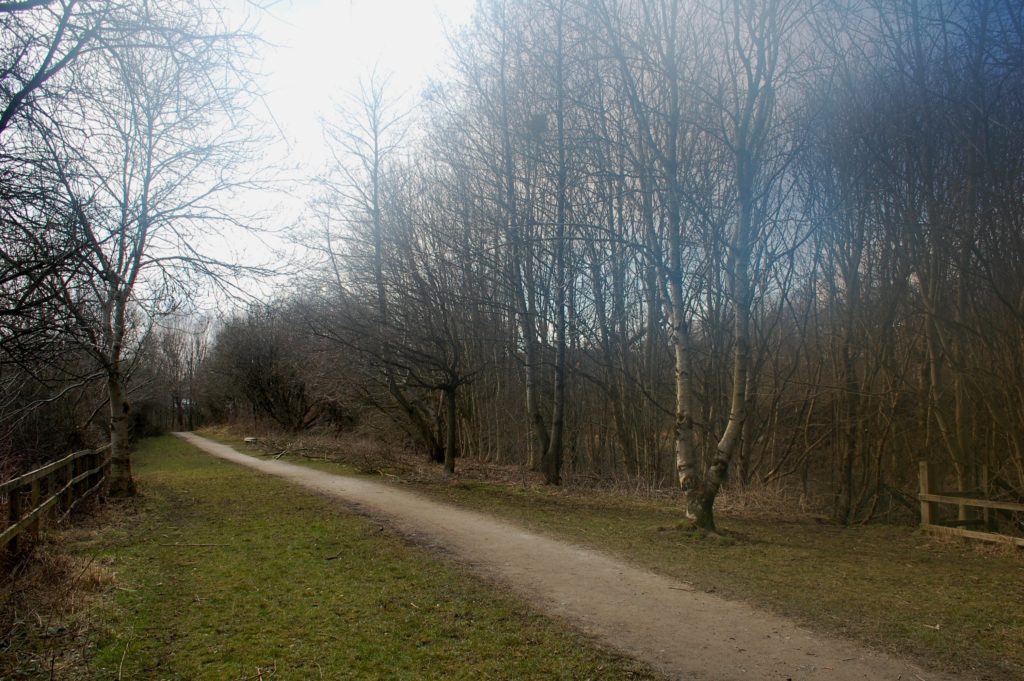
Glen Mill PoW Camp, Oldham
This page is often updated with new information and memoirs. Please see updates within the main text and in the comments section below. Most recent update, 27 February 2023.
A visit to the site of Glen Mill Prisoner of War camp in Lees, Oldham, Winter 2013.
Please see Britain at War for details of a couple of PoW and internment camps at Bury and Air Raids & Bomb Sites for a few photos and stories about air raids on Oldham.
Photo above; is looking towards the site of Glen Mill from the line of the now dismantled railway.
Below; a train passing Glen Mill in 1955.

Below; Glen Mill from the cemetery.
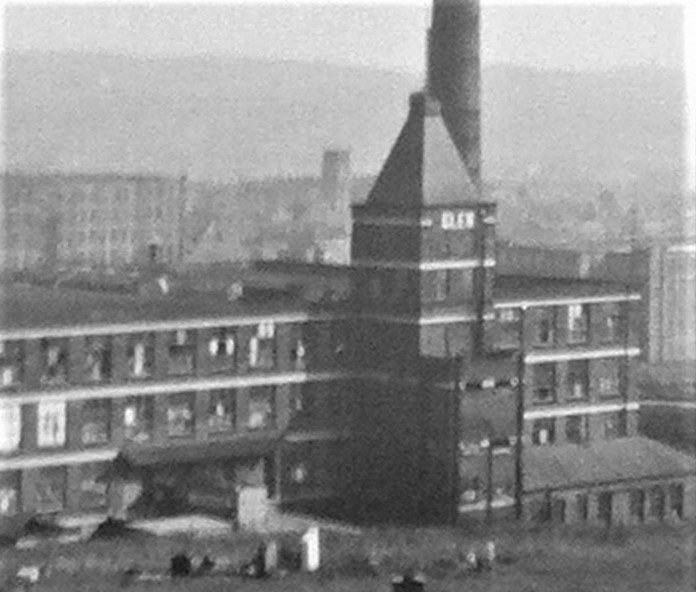
One of the main prisoner of war camps in the north west of England, the now demolished Glen Mill was situated between Wellyhole Street / Constantine Street and the River Medlock at Lees in Oldham (Grid Ref SD 949 049).
These photos were taken January 2013 during a visit to look for traces of the camp. There is not much left, though some local people were able to confirm the spot.
It is possible to find bits of concrete and iron which date from the war and piles of red brick from the now demolished mill.
Below; This first photo shows a new wall on top of what was a pill box overlooking the main entrance. There is a similar mound just next to it.

Below; Bit of metal jutting out of the ground in the woods between the camp and the river.
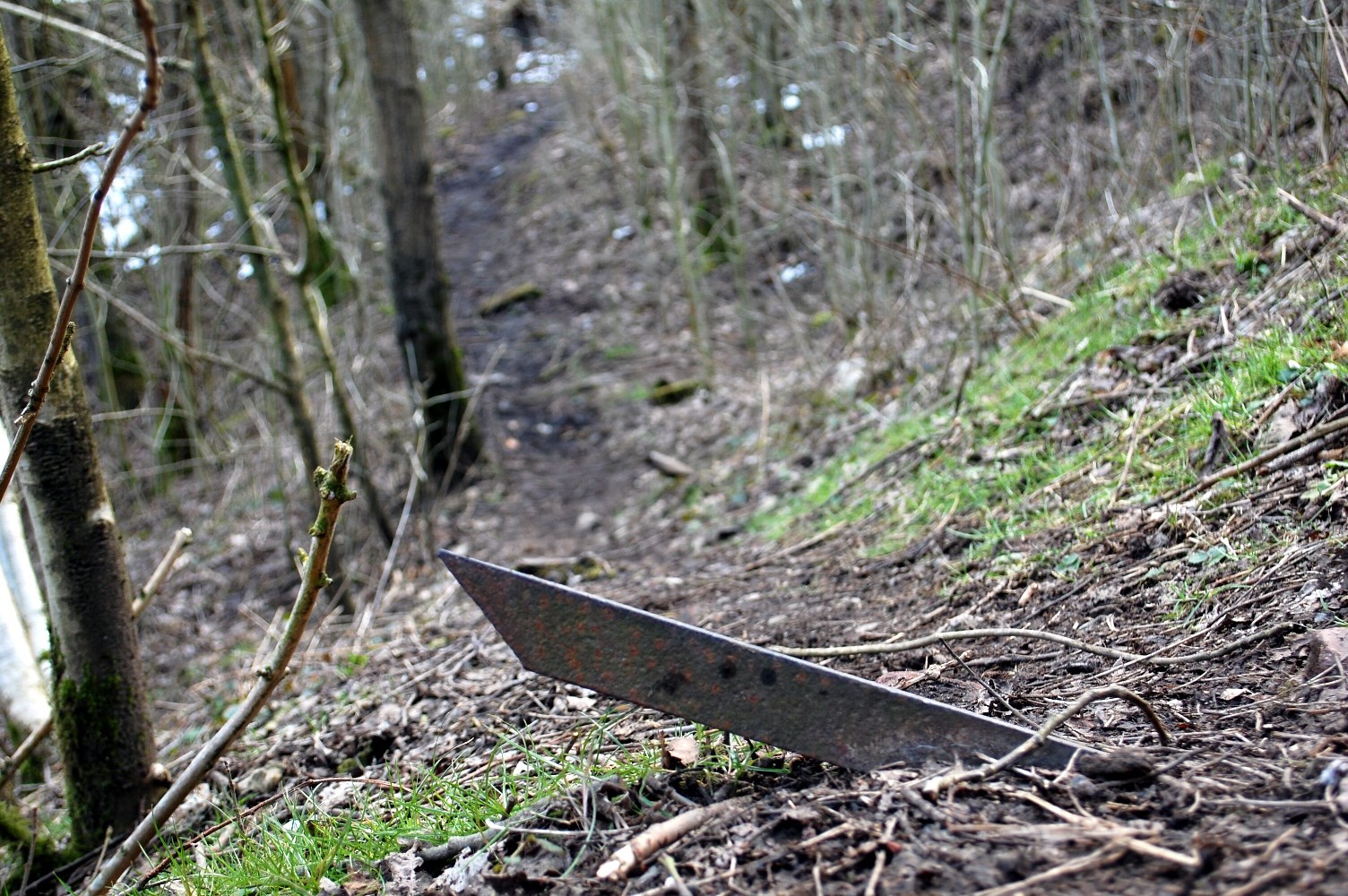
Below; Fence post. Some iron gates nearby appear to date from the war too.
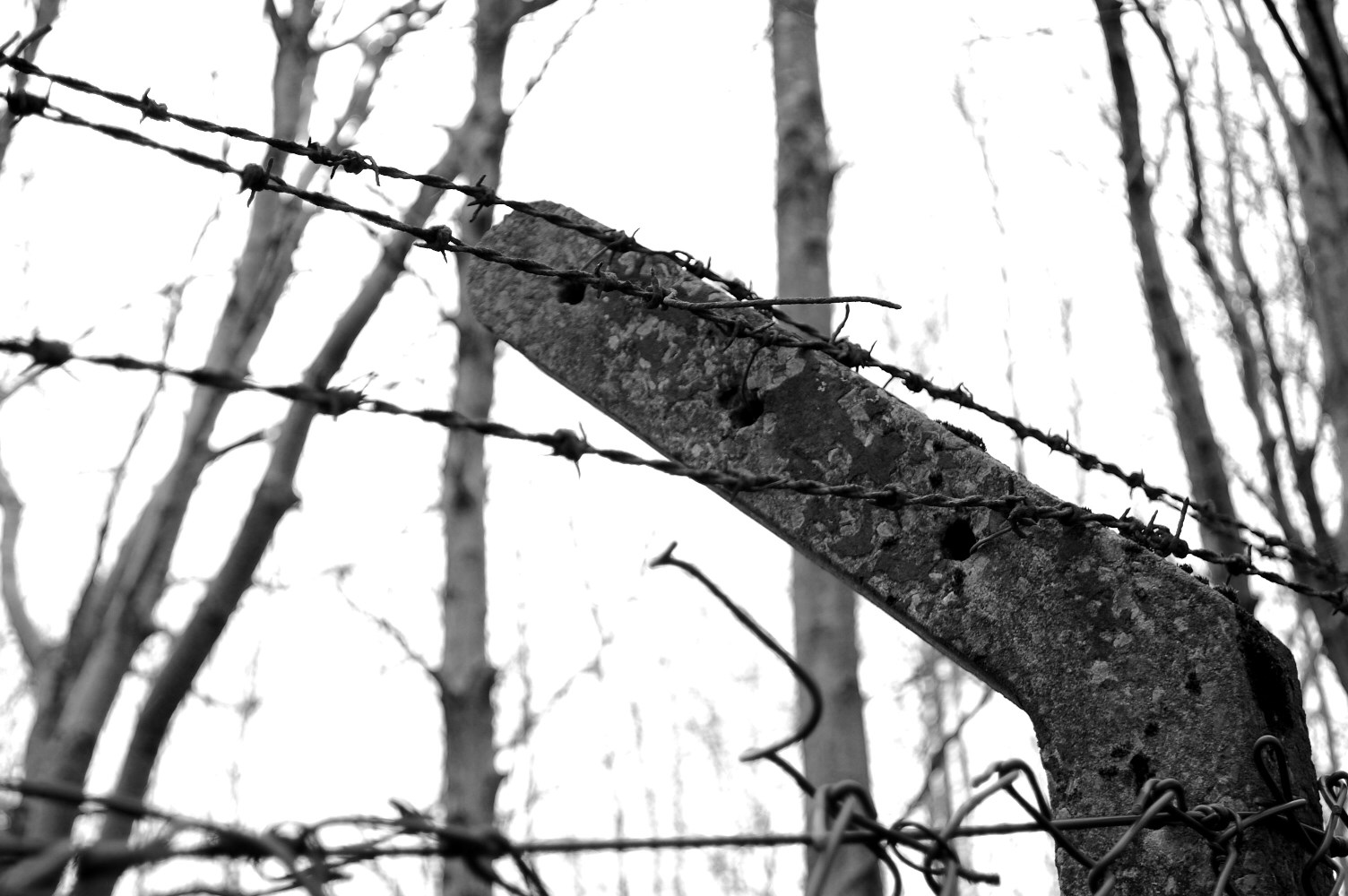
The camp could accommodate around 6,000 inmates and during the course of the war was home to a largely transient population of German and Italian prisoners and also some Russians who had been fighting for the Nazis.
Christmas 1942 saw the camp filled with Italians captured at Libya, while the summer of 1944 saw the camp filled with Germans captured at Normandy.
Below; Remains of drainage system
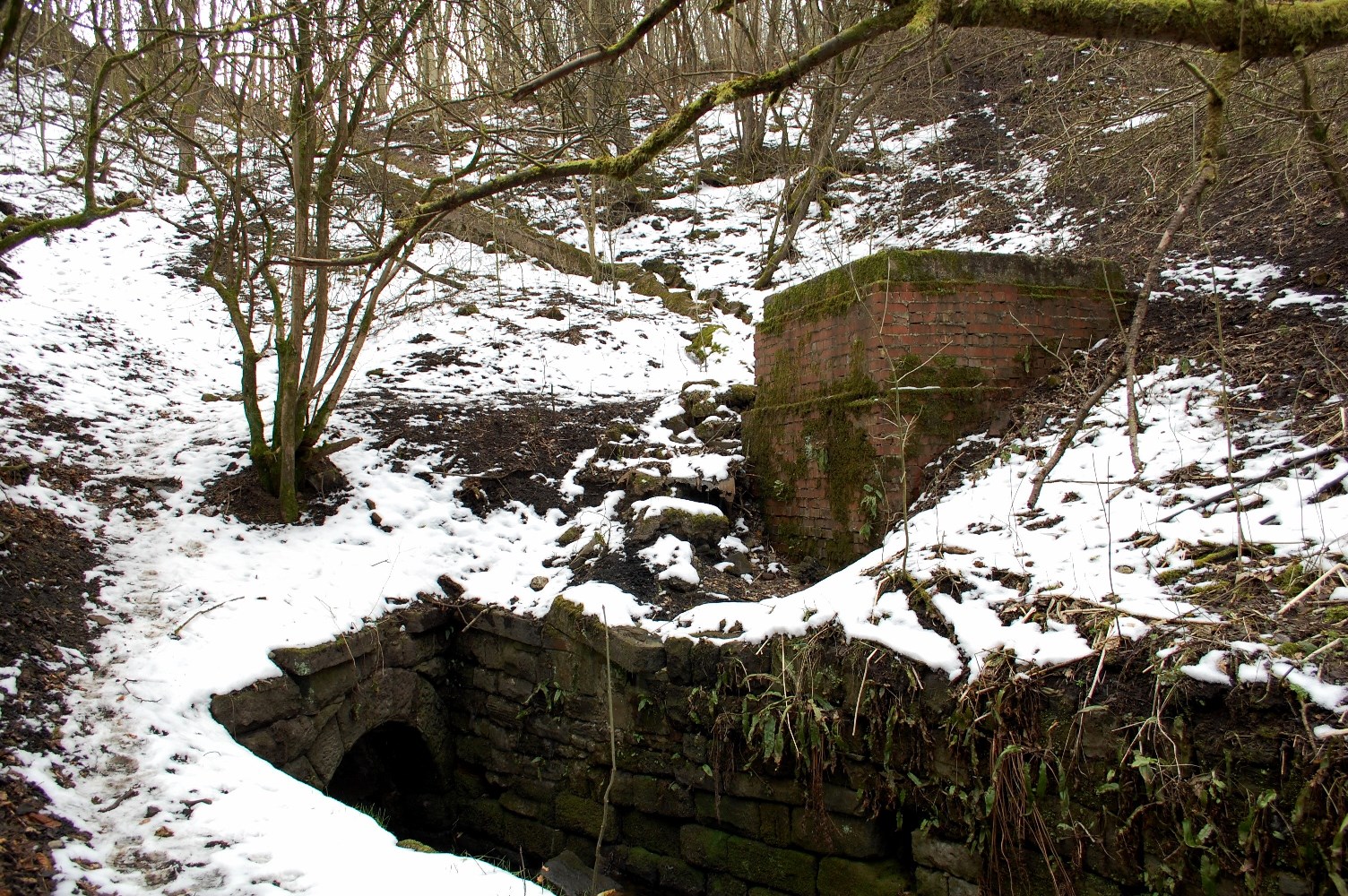
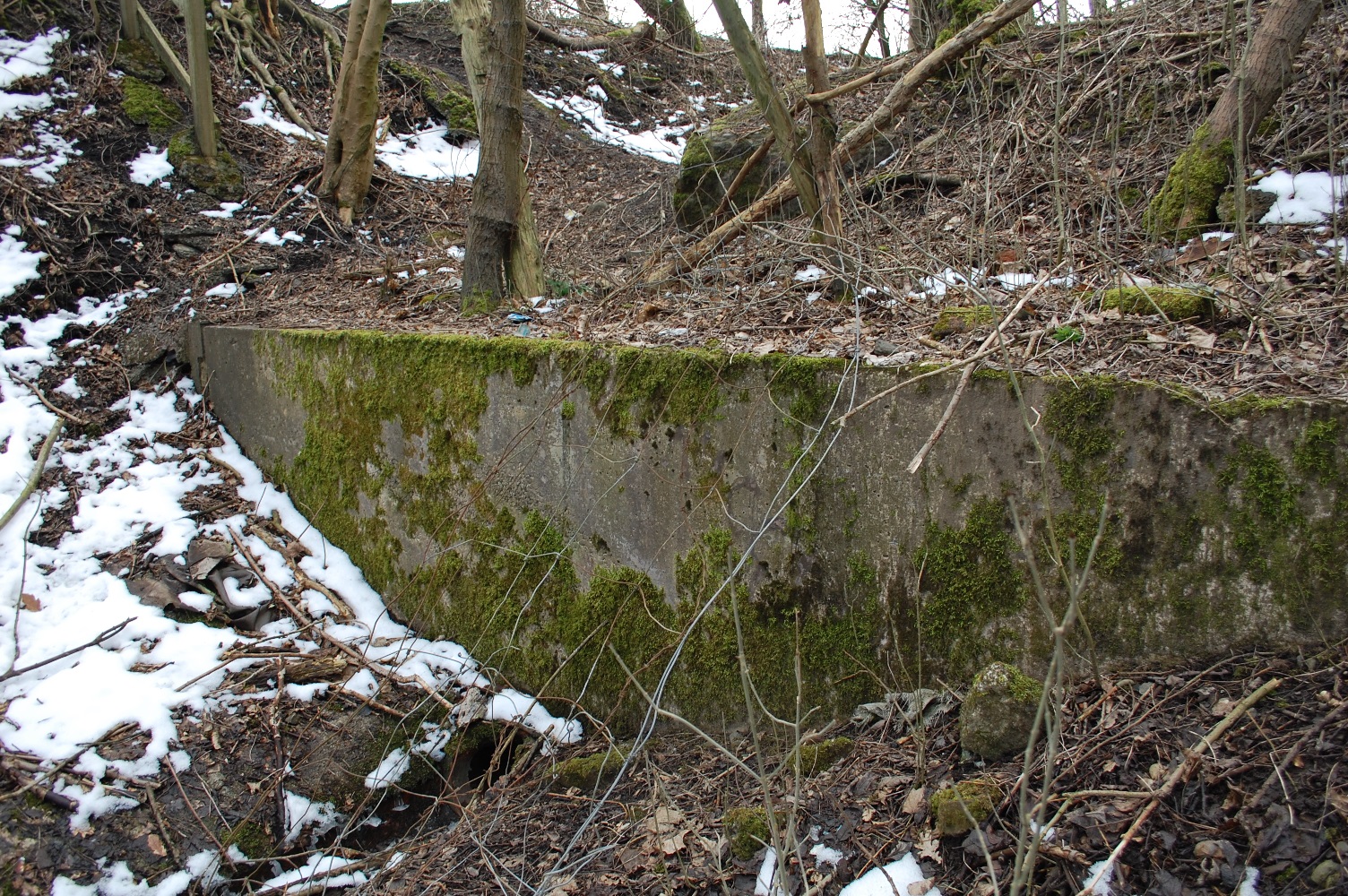
The April 2013 issue of Britain at War magazine tells the story of prisoner Paul Hartmann who was shot dead by Gunner J A Jaffray in February 1945. The incident came after a roll call lasting hours and during which the Germans had obstructed the counting to cover up an escape attempt.
As rain began to fall, the inmates started shuffling forward towards Gunner Jaffray who was at a sentry post and armed with a Lee Enfield .303 rifle. At the inquest, the British said the Germans were restless and being obstructive, refusing to obey orders, singing Nazi songs and insulting the guards. The Germans said they were singing love songs and were not abusing the guards at all!
Either way, Gunner Jaffray challenged the prisoners to halt in their advance towards him. He was ignored and believing he was about to be over-run by the mass of prisoners, he fired from the hip into the crowd. The bullet struck 18 years old Paul Hartmann, killing him instantly.
The article quotes Unteroffizier Fritz Hermann Scheer; “We were jumping about to keep warm. Suddenly I heard a report and felt something on my face. I put my hand up and found blood and bone splinters on my face. My eye and cheek were cut by splinters. In my eye it was metal, in my face it was bone.”
Gunner Jaffray was exonerated at the inquest the following April. That same month, an Italian prisoner of war at Bury was hailed as a hero for giving his life to save that of a young girl from drowning in the River Irwell.
Please see the image below from the Daily Herald showing PoWs giving the Nazi salute at Paul Hartman’s funeral (under heading 29 May 2017 update)
Below; Photos taken at Glen Mill POW camp on Christmas Eve 1940. Photos used with IWM Non-Commercial Licence.

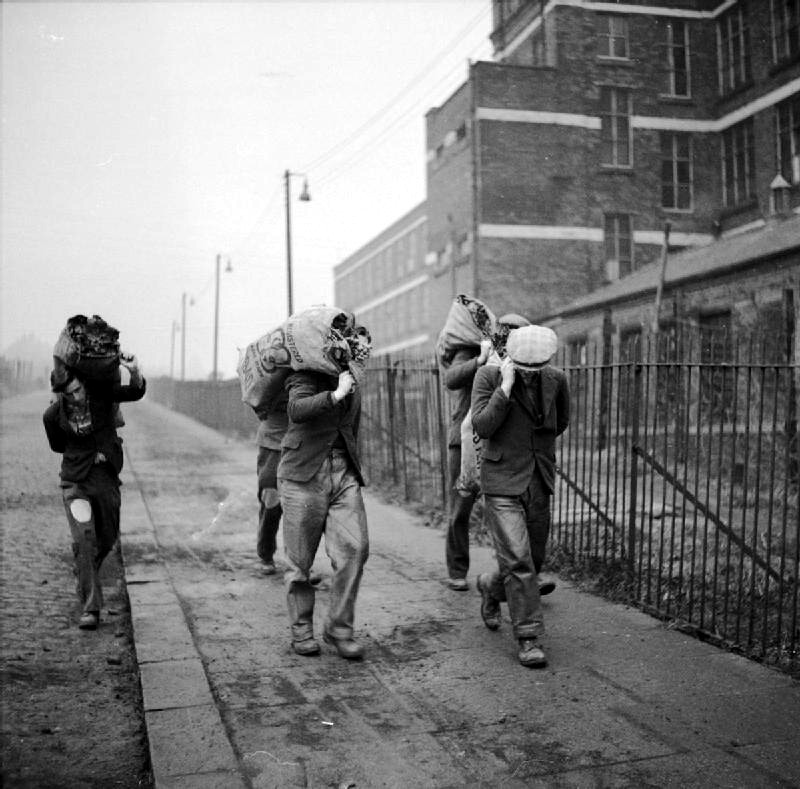
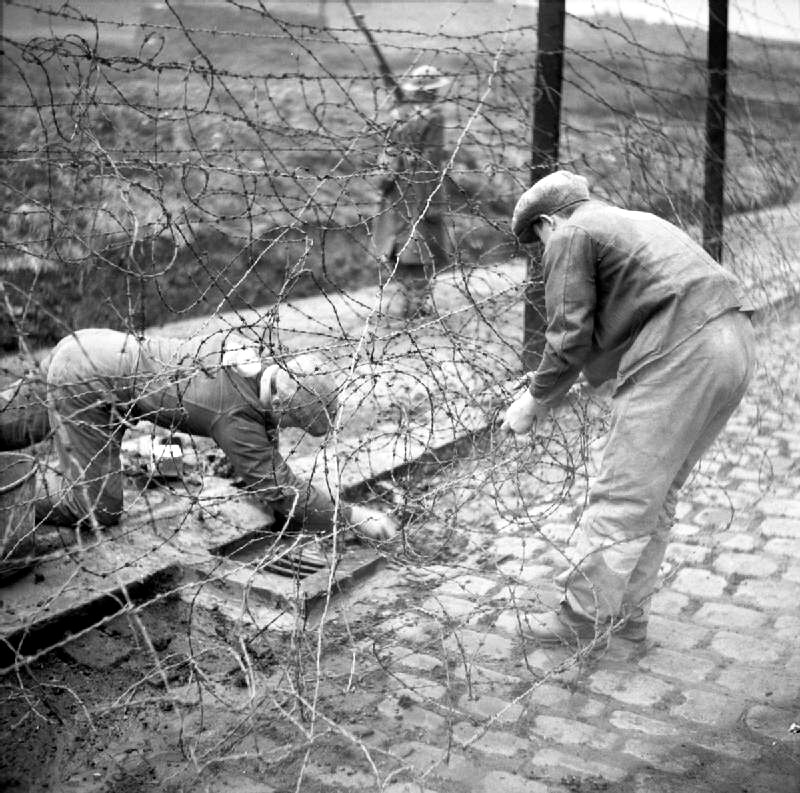

The same day these photos were taken, just a few miles away in Manchester, fire crews were dealing with the results of Luftwaffe bombing raids on the city. This is Piccadilly. Click on this link for more about air raids on Manchester.

This is part of a Luftwaffe map (from the British Library) for Manchester, showing the camp circled with a note for bomber crews to avoid hitting the area. The note says “Achtung Deutsches Gefangenenlager in Oldham – Leeds” (“Attention German prison camp in Oldham – Leeds”; the cartographer confusing the Oldham place name Lees with that of the city of Leeds)
I am uncertain as to the source / copyright of this photo, if anyone knows, please advise?
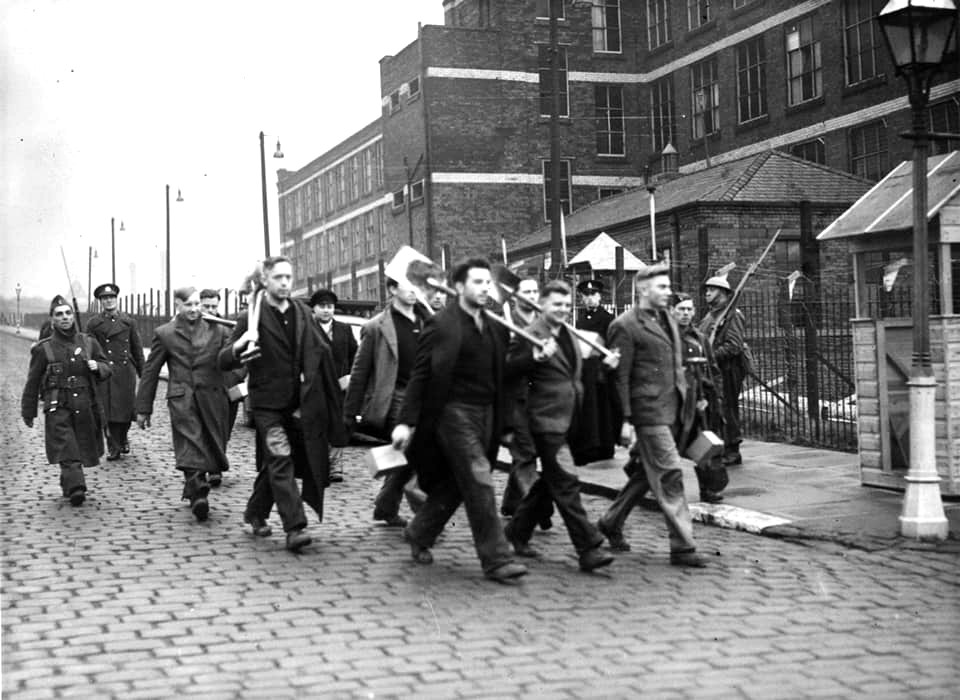
MORE
My photos and story of the German Military Cemetery in Staffordshire
This British Pathé video shows German PoWS at Glen Mill
UPDATES AUGUST 2015
These five images have been provided by James Farrell and are used here with his kind permission. Earlier this summer, Jim was visiting an antiques shop in Bristol and the lady who runs it said she had something “a bit special” which might interest him. It was a sketchbook which has on the front cover the name Friedrich Fraubose and a watercolour painting of the town of Hildesheim which is south of Hannover. Jim says “the book contains a watercolour cartoon history of approx 30 pages from when he first arrived to when he left Glen Mill. The front pages of the book also contain watercolours of places in Germany.”
It is really interesting to get a glimpse Glen Mill from the perspective of the prisoners of war.
Jim also purchased a plaque which has the crest of the Dorsetshire Regiment at centre, with two swastikas, a Luftwaffe eagle emblem top left (without a swastika in its claws) and a German eagle emblem bottom right, again with no swastika. Jim says “The plaque is made of wood and probably made from a cupboard door, it has been made and painted extremely skilfully, and is signed with the initials FF in the bottom RH corner.”
(NB; Jim has kindly sent me all 31 images. I have uploaded all these in a separate page, please see here)
The plaque has the words OLDHAM KRIEGSGEFANGENSCHAFT ENGLAND – kriegsgefangenschaft means prisoner of war.
Below; Front cover;

Below; a few examples from the book The caption refers to the morning head count to make sure no-one had escaped during the night.

Below; This looks like a carpentry workshop. Note the patches on the uniforms, which were a way of grading prisoners. Compare this sketch with the photo above of PoWS outside Glen Mill carrying sacks; you can see the same patches on the legs of their uniforms.
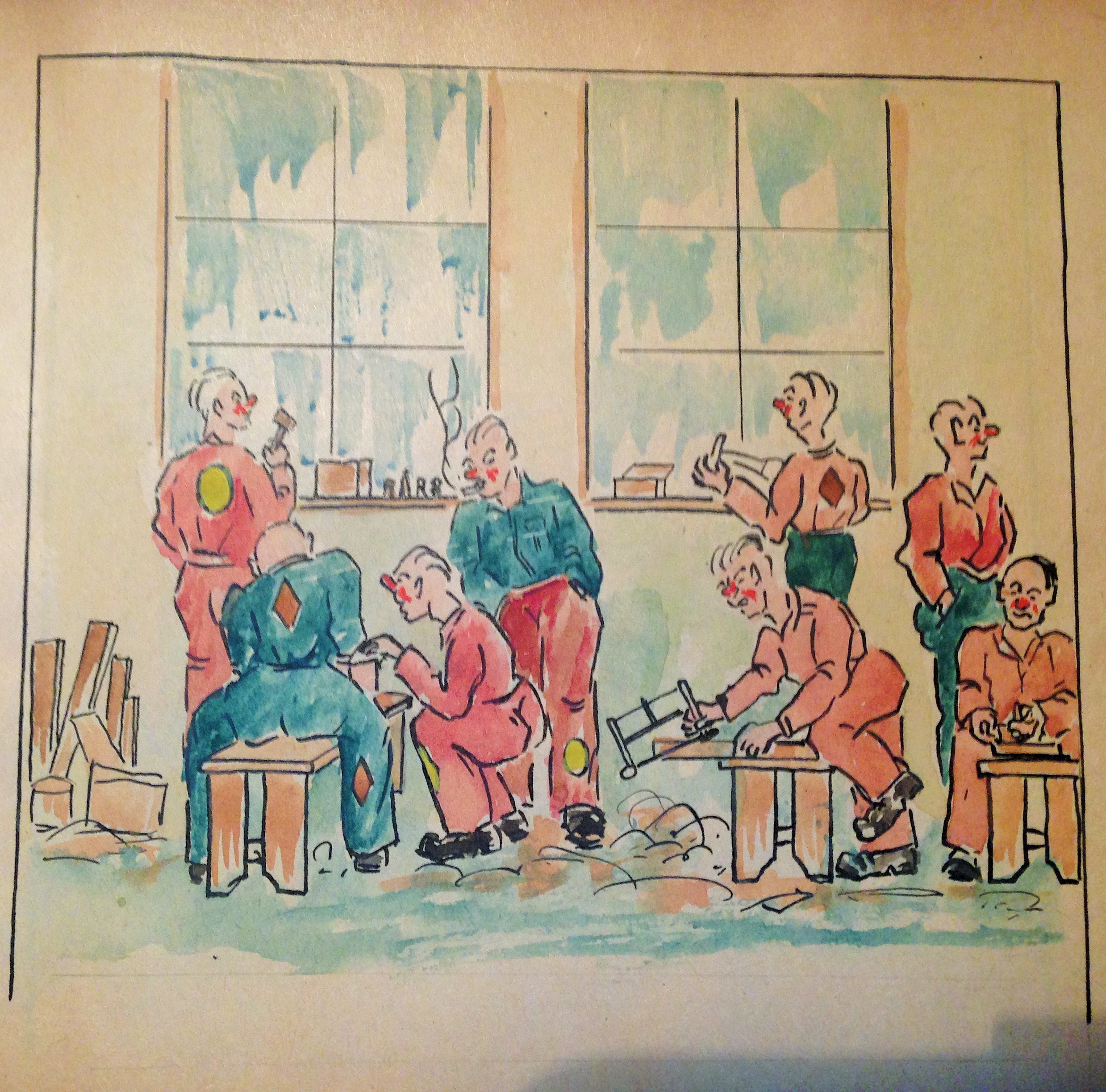

Below; the plaque
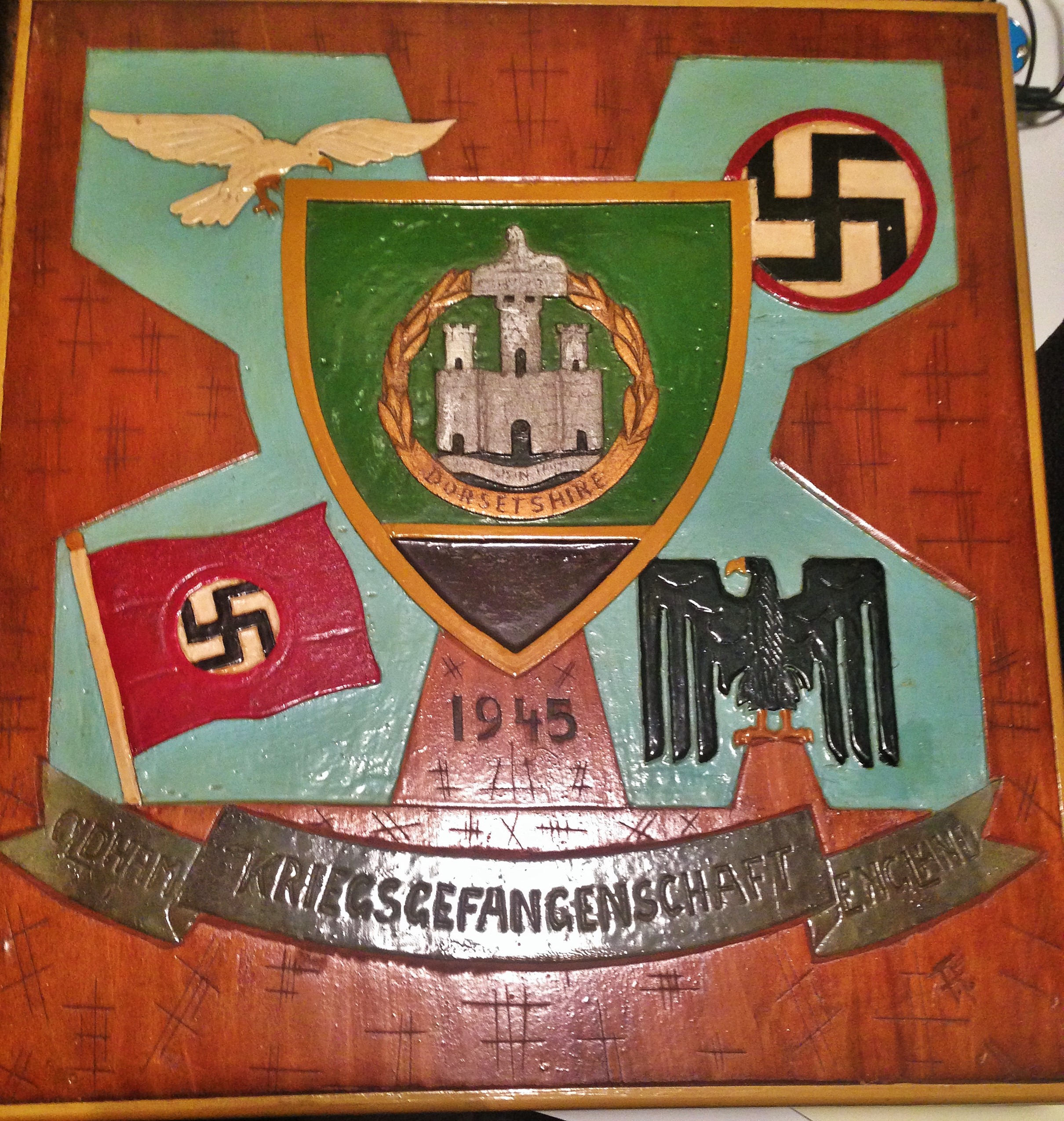
Below; The same day I received the pictures of the sketchbook, I also received this photo of a tankard presented to Lieutenant Colonel W S Tanner OBE, TD of the Royal Pioneer Corps on the occasion of his retirement in 1947. By this time, Glen Mill was a transit camp. Photo courtesy of Dave H and used with his kind permission.

UPDATE SEPTEMBER 2016
Below is a copy of a handwritten account kindly provided by Mr Steven Kay from his late aunt Mabel Entwistle and refers to her husband John (Jack) Entwistle who was caretaker at Springhead Drill Hall, now Springhead Community Centre (21 Ashes Lane, Springhead, Oldham OL4 4PF).
The account mentions two PoWS from Glen Mill. It is included here as it adds more to what we know about the relationship between some of the prisoners and the people of Oldham.
Mabel wrote “My husband was invalided out of the Army 1946? & given a job looking after Springhead Drill Hall & lived in the adjoining house. Winter of 1947 very harsh the approach to drill hall was snowed up every morning 2 prisoners from Glen Mill were sent to clear the snow. The one who spoke English best was Paul Lebau who had been a PoW for some years, some of them spent in Canada before coming to Glen. He found it an enjoyable change and couldn’t do enough for us at the Drill Hall. On March 1st that year my sister was getting married & we were attending and going in our own little Morris 8? (it was the day before). The PoW was to journey back to Germany for repatriation & his last job he did for us was to polish the little car until it shone, in appreciation for getting him one or two things like coffee etc at the shop as they were non existant in Germany.
The other POW was more of a boy & though Paul had a wife back home this boy lived with his mother & when finally returned home I received a very grateful letter from his mother thanking me for showing kindness to him.
My husband and myself went living in Canada in 1953 & Paul Lebau & us corresponded together.”

UPDATE 29 May 2017
Photo kindly provided by David Lonergan showing the funeral of Paul Hartmann, the PoW referred to above who was killed by a shot from a guard’s rifle during a disturbance at the camp.
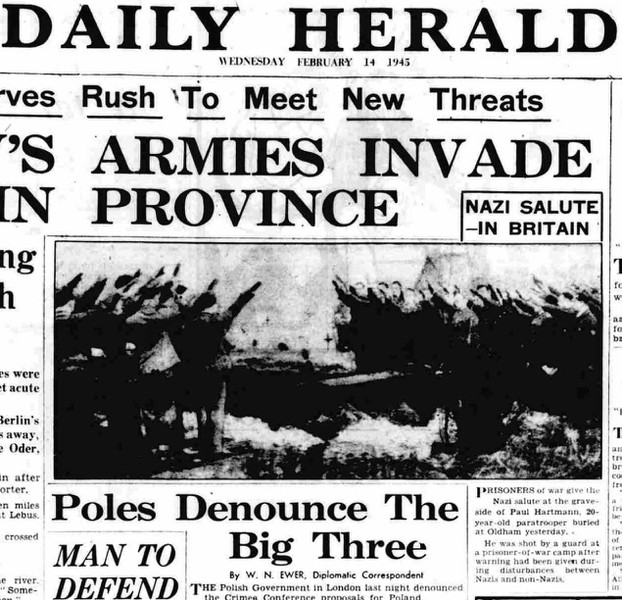
UPDATE 25 NOVEMBER 2017
Following on from the watercolour sketches of Glen Mill by a German PoW called Friedrich Frauböse, I have received some other wonderful sketches from Glen Mill by another German PoW whose name was Feldwebel Theodor Vater, a Luftwaffe pilot or crew member.
They have very kindly been shared with us by Sean Claxton, a British tour guide to the Normandy battlefields. They were provided to him by a German tourist, a Dr Pruder whose wife’s uncle was Theodor Vater.
Sean writes,
“Vater was captured on 22nd September 1940 having been shot down over the English Channel. He was seen thanks to releasing some dye into the water, which stayed on him for some time too, apparently.” He adds that he was picked up by the British and spent some time as a PoW in the UK before being transferred to a camp in Canada. Sean says that Feldwebel Vater gave other prisoners English lessons and adds that at 32 he was an older man compared with most of his fellow inmates.
I am hoping to receive some further information about Feldwebel Vater. On the reported day there was apparently very little activity in the air owing to bad weather. A couple of reports state that the only German aircraft shot down was a “lone Ju88 on a photo or weather reconnaissance mission was detected over the Channel south of the Isle of Wight and 234 Squadron from Middle Wallop sent one flight to intercept. The Junkers was shot down and made a belly landing in the sea. All the crew managed to get out of the sinking aircraft and were captured by British authorities.”
UPDATE 14 June 2021 Fw Vater was Beobachter (i.e observer) on Ju88A-1 7A+AM Wn.0352, a weather reconnaissance flight over the English Channel off Newhaven. The crew had sent their report but were attacked at 6,500 feet by a Spitfire at 1315 on 22 September 1940. The Ju88’s starboard engine was hit and the aircraft ditched in the Channel. The crew were able to get into their dingy and were picked up by a trawler ten hours later. The crew initially refused to give up any information about the purpose of the flight.
Details from Luftwaffe Crash Archive Volume 4, Nigel Parker 2014.
Photos below are courtesy of a Dr Pruder via Sean Claxton and used with kind permission. Regarding the photos, I have not edited these in any way, they are as scanned by Sean who notes that the 5th sketch was done on a packet of dental magnesium and the 6th sketch was done on the back of a cigarette packet. To zoom in and see them better, just right click over a picture and select ‘View image.’
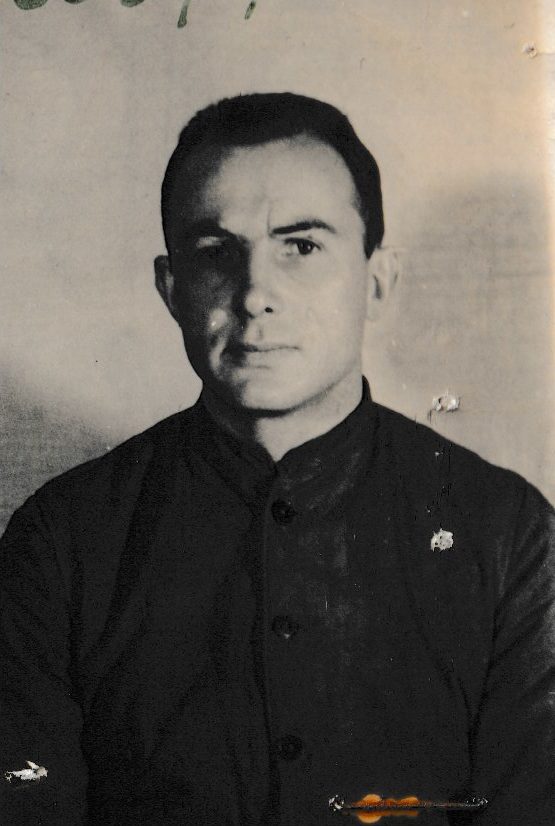

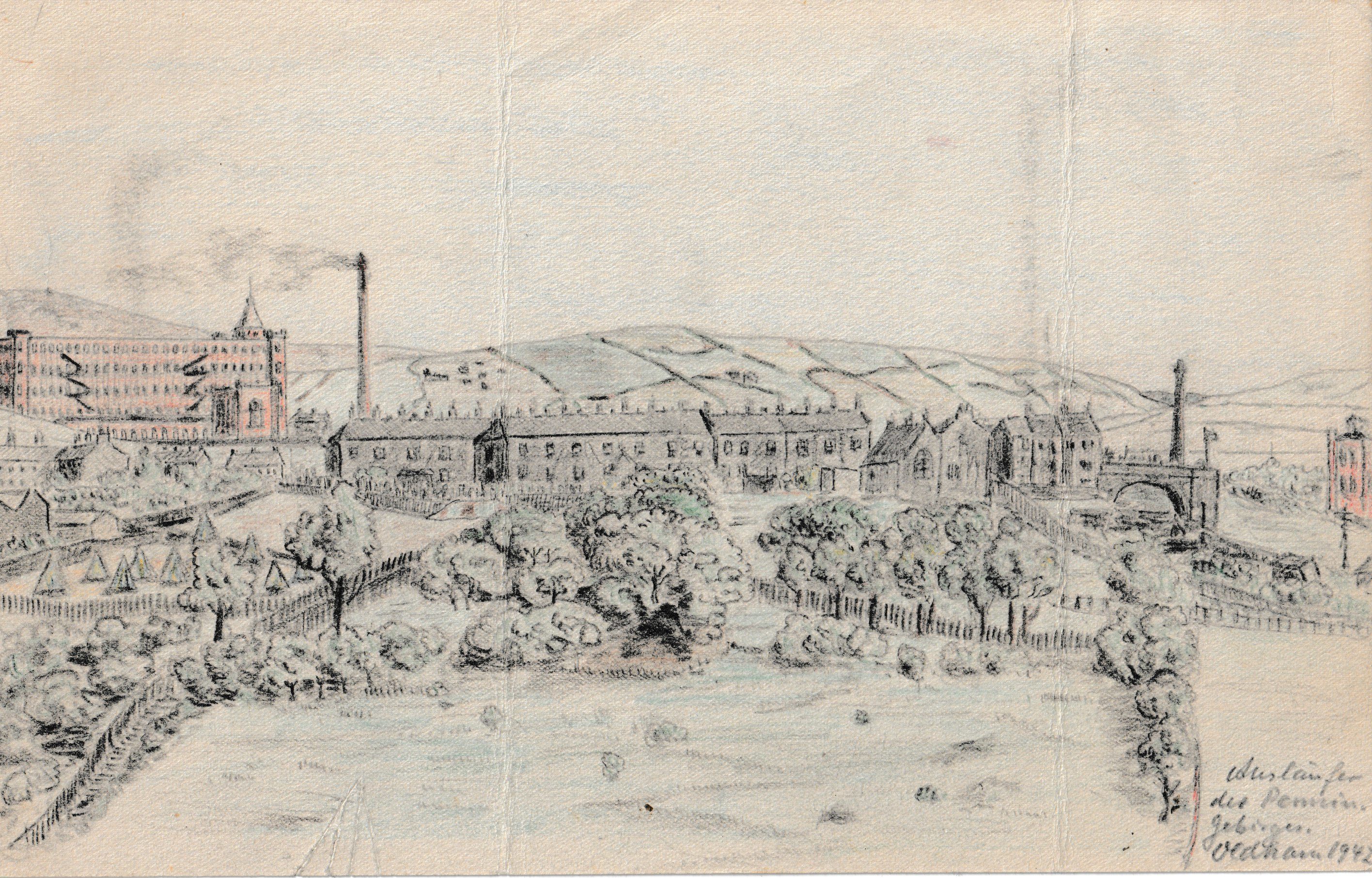
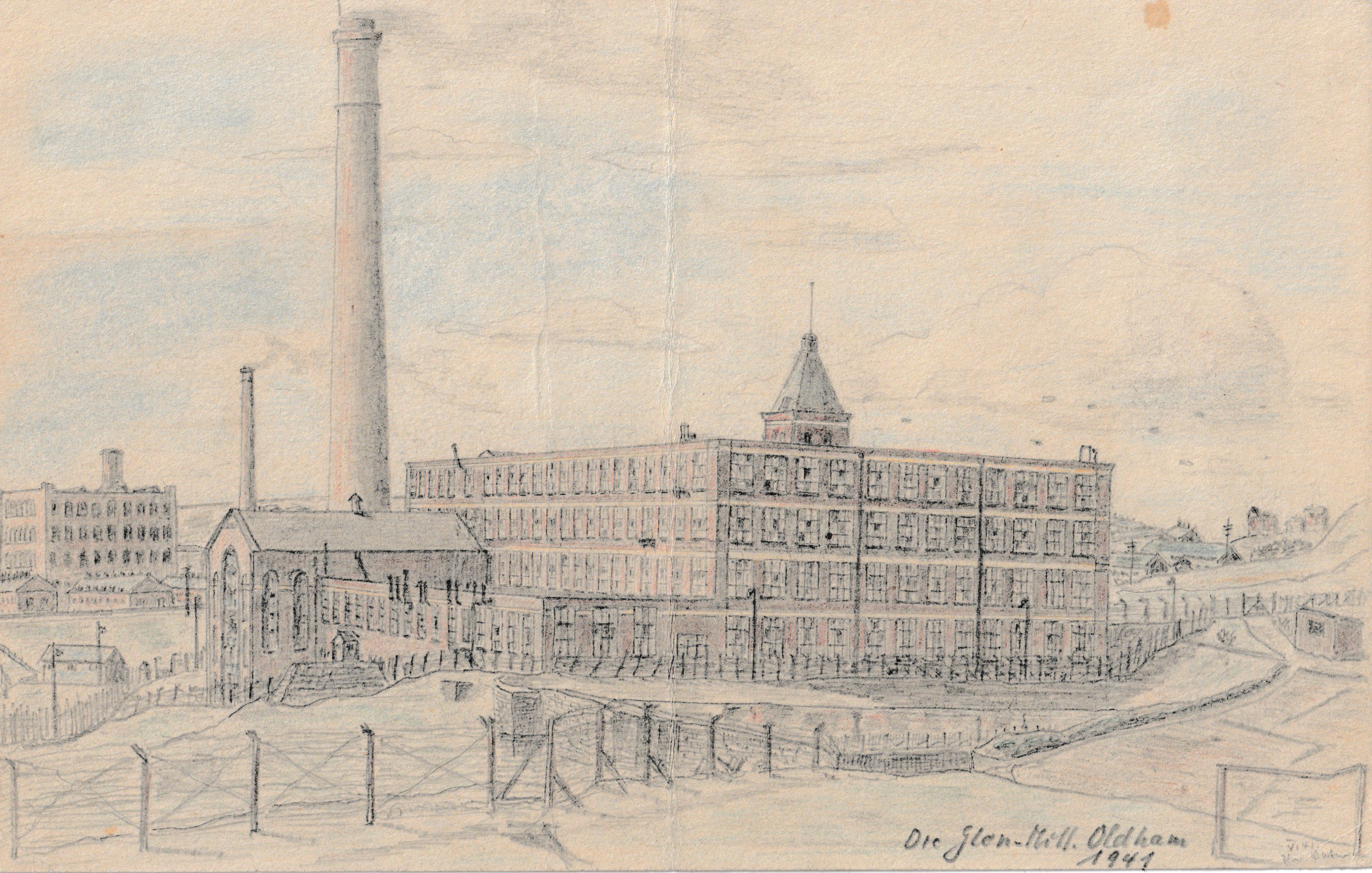
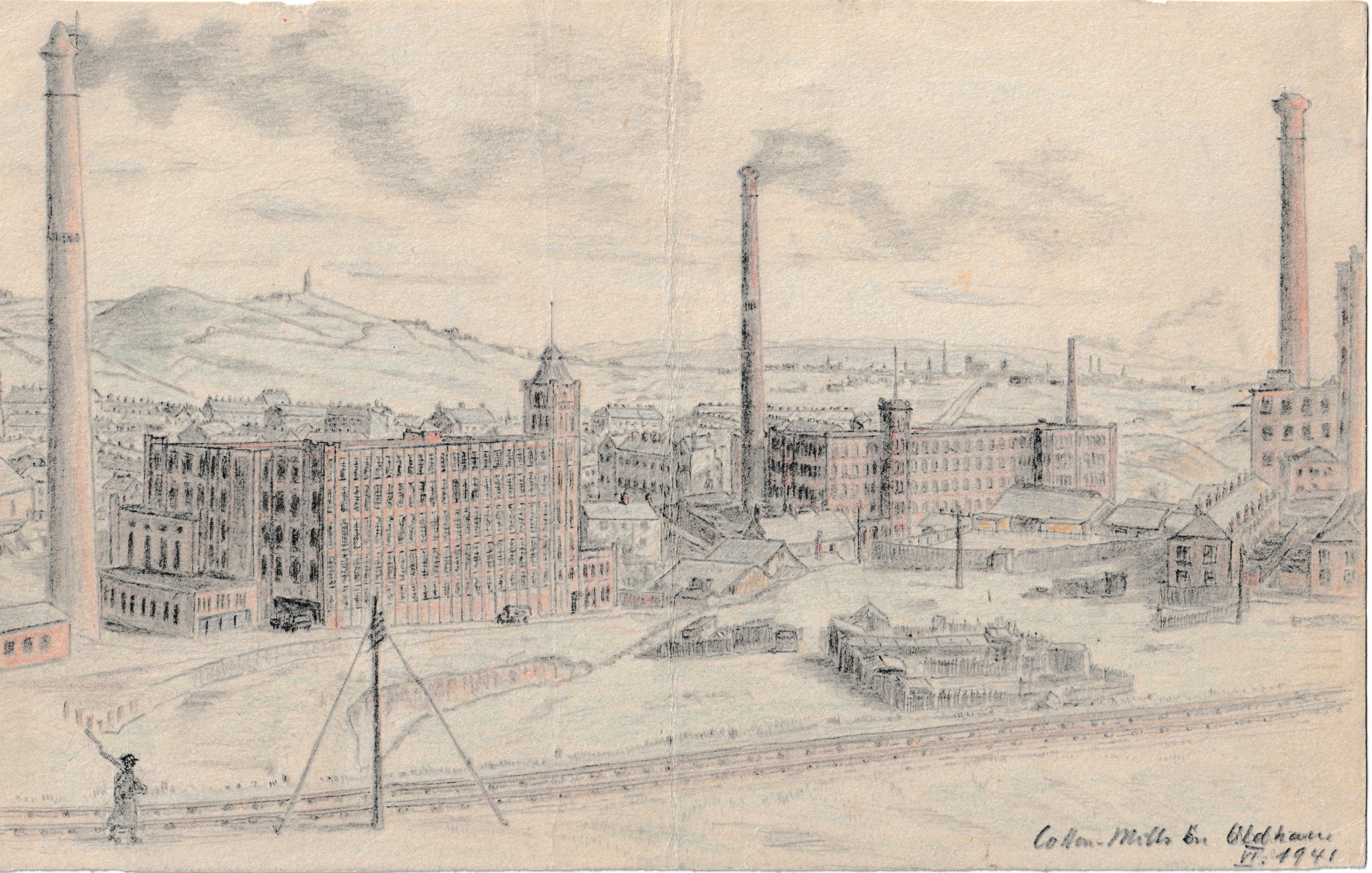
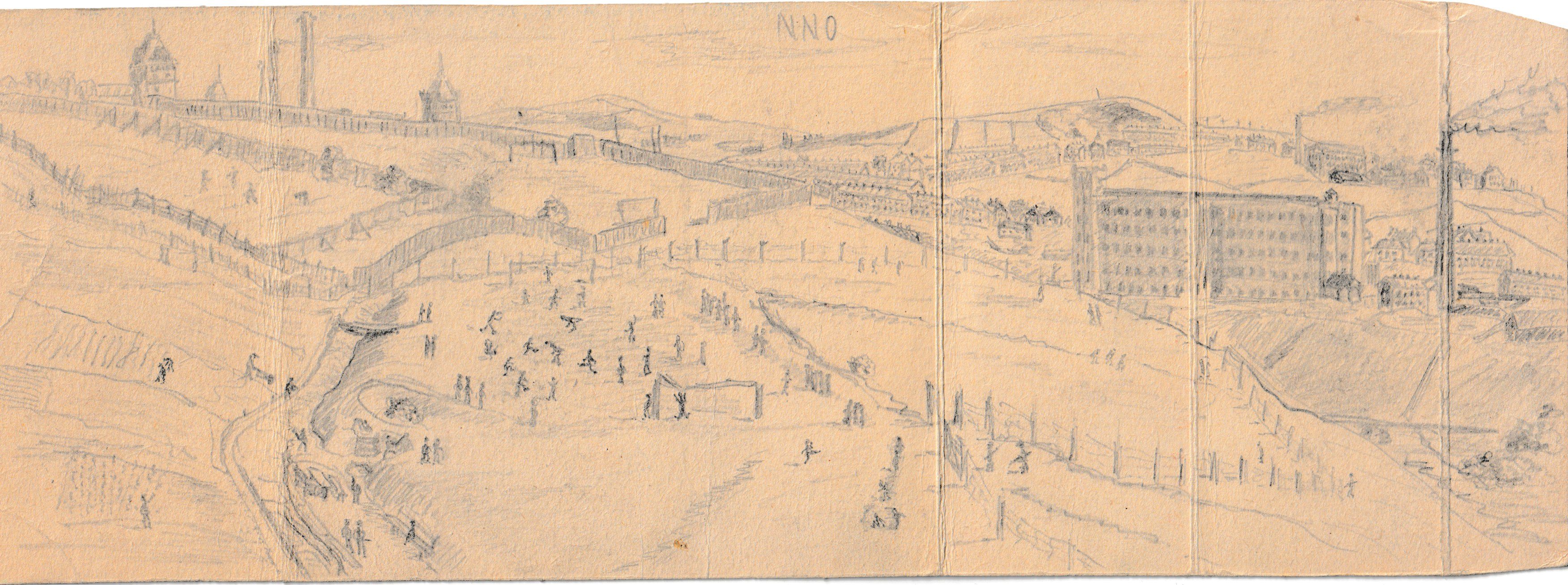

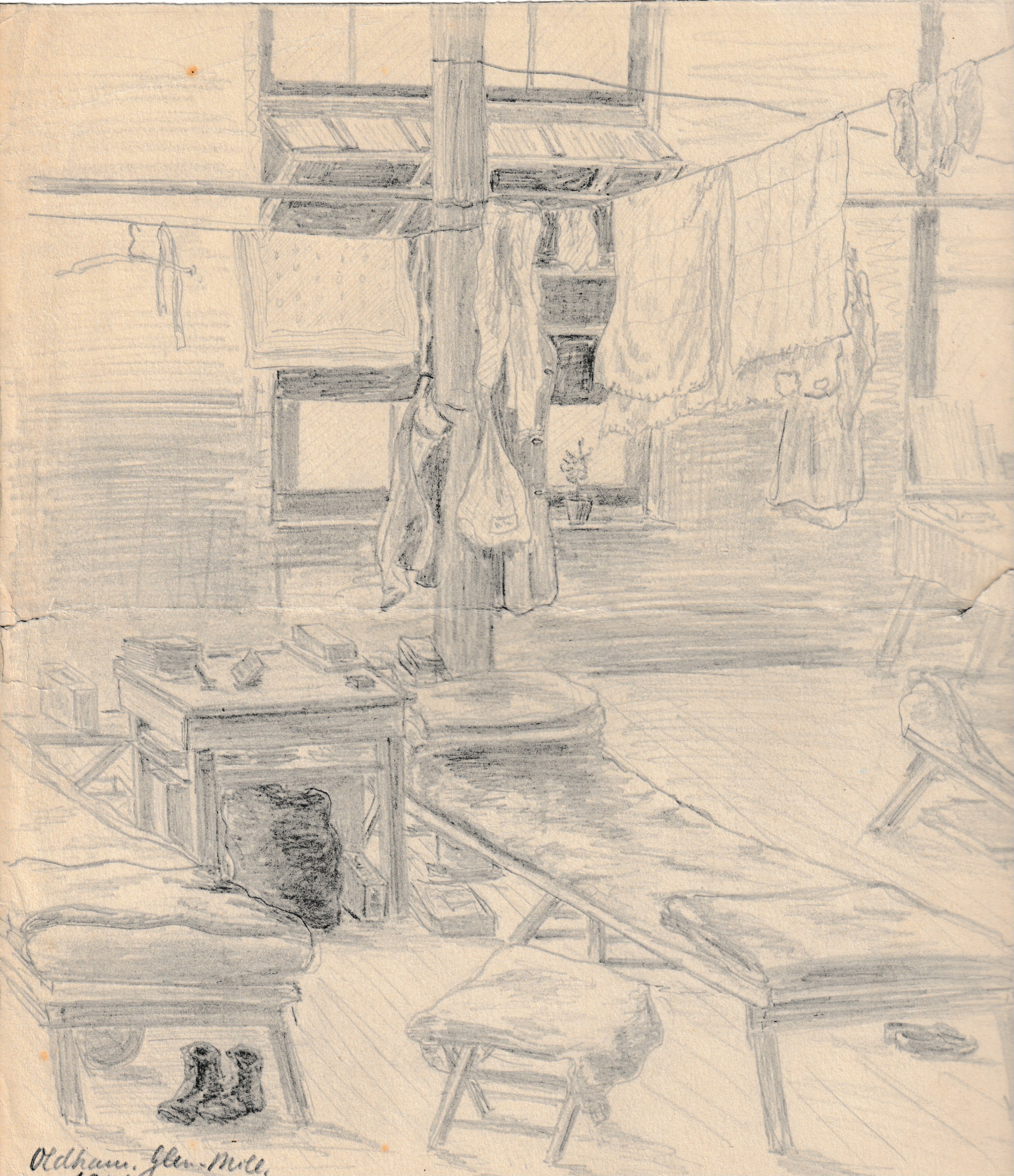
UPDATE 19 February 2022
Re the request for information below, Mr Taylor has noted the German PoW referred to here was at Hemel Hempstead and may not have been at Oldham at all, but this update will remain in case anyone viewing this page has information about Walter Reeh.
Request for information from a Mr Eric Taylor of Seattle. He posted a query in the comments thread, but it is copied here for convenience;
“Seeking information on a German POW, Walter Reeh, who may have been held at the Oldham, Lancashire, camp. A photo of a group of 13 prisoners, including Walter, taken 5 May 1946, includes a placard at their feet that includes the date, a large number “2” and the initials “OL” which leads me to believe they stand for Oldham, Lancashire. The photo postcard was sent to Walter’s brother, Reverend A.E. Reeh, First Baptist Church, LaSalle, Colorado, via Prisoner of War Post, or Kriegsgefangenen Post. A stamp on the back of the postcard reads: “German P.O.W. (W) Camp 235 Gt. Britain.”
Mr Taylor adds that Walter Reeh is seated second from left in the photo. If anyone has any information, please reply here or email me and I will forward to Mr Taylor. My email address is on the contact page of this website.
Ian
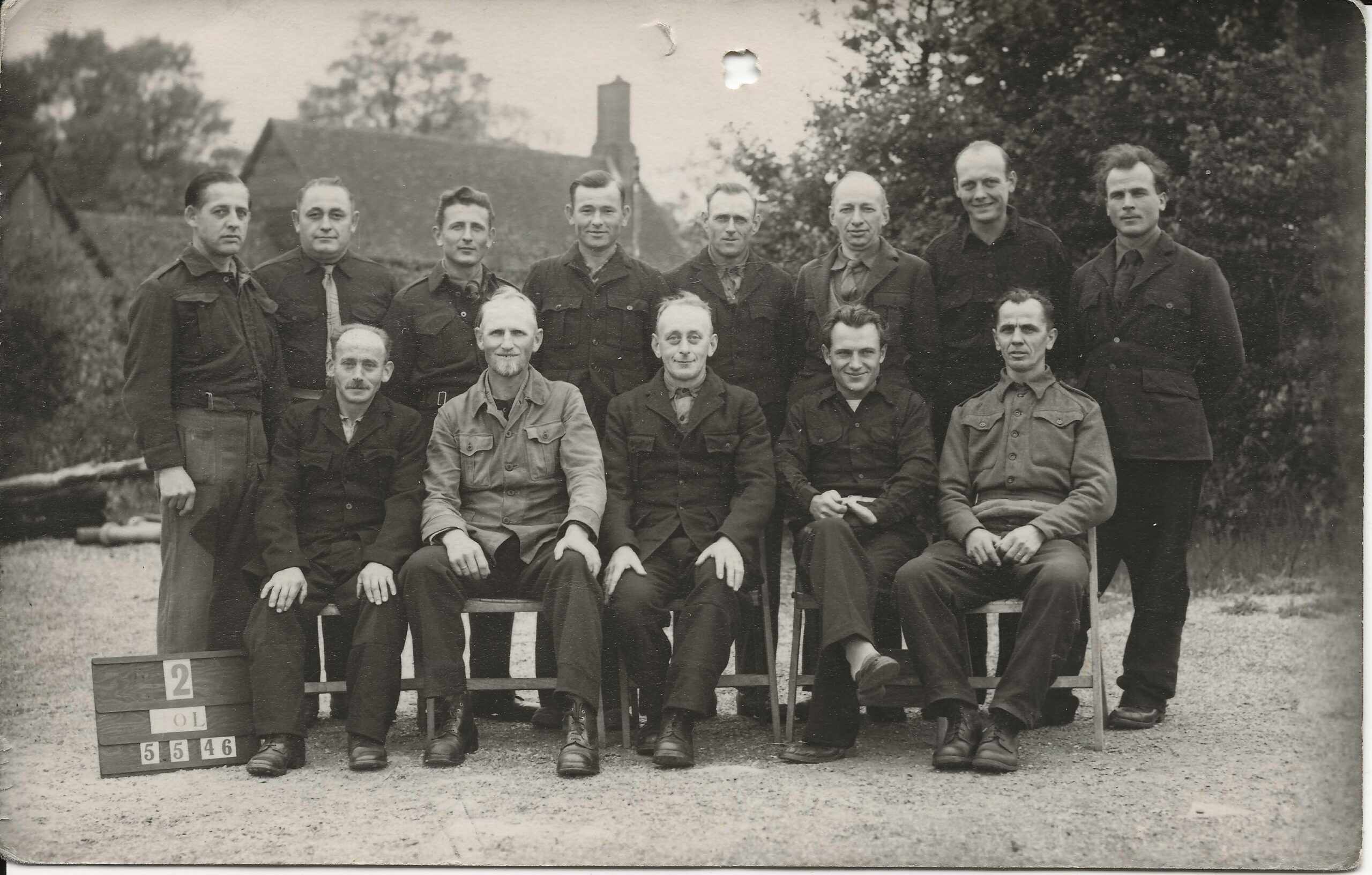

UPDATE APRIL 2022

The photo above is of the late Otto Adler, a former PoW at Glen Mill. It is provided by Patricia Clarke and is used here with her kind permission.
Patricia told me about Otto, how he and his friend Karl Gruene worked on farms on Alt Lane, Oldham at the end of the war. The two PoWs worked with the brother of Pat’s friend Elsie, who is in her 90s now and lives in Oldham. As a teenager, she lived with her family next door to what was The Welcome Inn on Abbeyhills Road. Elsie became friends with Otto and Karl after an incident which Pat describes:
Across the road at the end of Alt Lane, the German POWs used to wait in all weathers to be picked up by trucks after working at the local farms. One day it was freezing cold and raining and Elsie’s mum sent her across the road with mugs of hot tea to warm them up, showing compassion. The view of Elsie’s mother was that “They are someone’s sons and husbands, and I would like to think if it were our lads, someone would take care of them,”
When they watched from their window they saw the men spitting out the brew! Shocked and upset thinking they were being disrespectful and ungrateful she vowed not to do it again.Till someone alerted her to the fact that they were spitting out the tea leaves that they weren’t used to!
Otto was part of this group and built up a friendship over decades, each visiting the other after the war had ended and beyond.
By a remarkable coincidence, on another page on this website and relating to the V1 flying bomb which came down on Radcliffe near Bury on Christmas Eve 1944, someone called Charlotte commented ten years ago (April 2012) that as a 13 year old school girl, she was chatting with her PoW friend Otto Adler (in the story, Otto said to Charlotte, “I think you would have liked it to land on your school!”)
Four years later, another person of the same age and from the same school called Ian commented on how Otto was a paratrooper captured in Holland, and that he was a farmer from Ravensburg in Baden-Württemberg in southern Germany and how he visited often after the war. Ian says Otto died around 2014.
The reason Otto was at Radcliffe while an inmate at Glen Mill was because some prisoners were given jobs to do in the Manchester area. Elsie’s friend Brenda used to see the Germans marching to Mummps station, “singing their heads off.”
Of course there is another coincidence; the same morning that V1 bomb fell at Radcliffe, another fell at Abbeyhills Road in Oldham.
UPDATE 14 MAY 2022
This page has an interview with a former worker at Glen Mill, Trudy Costello who was born in Austria in 1932 and came to Oldham after the war.
Gertude Costello née Kogelnik
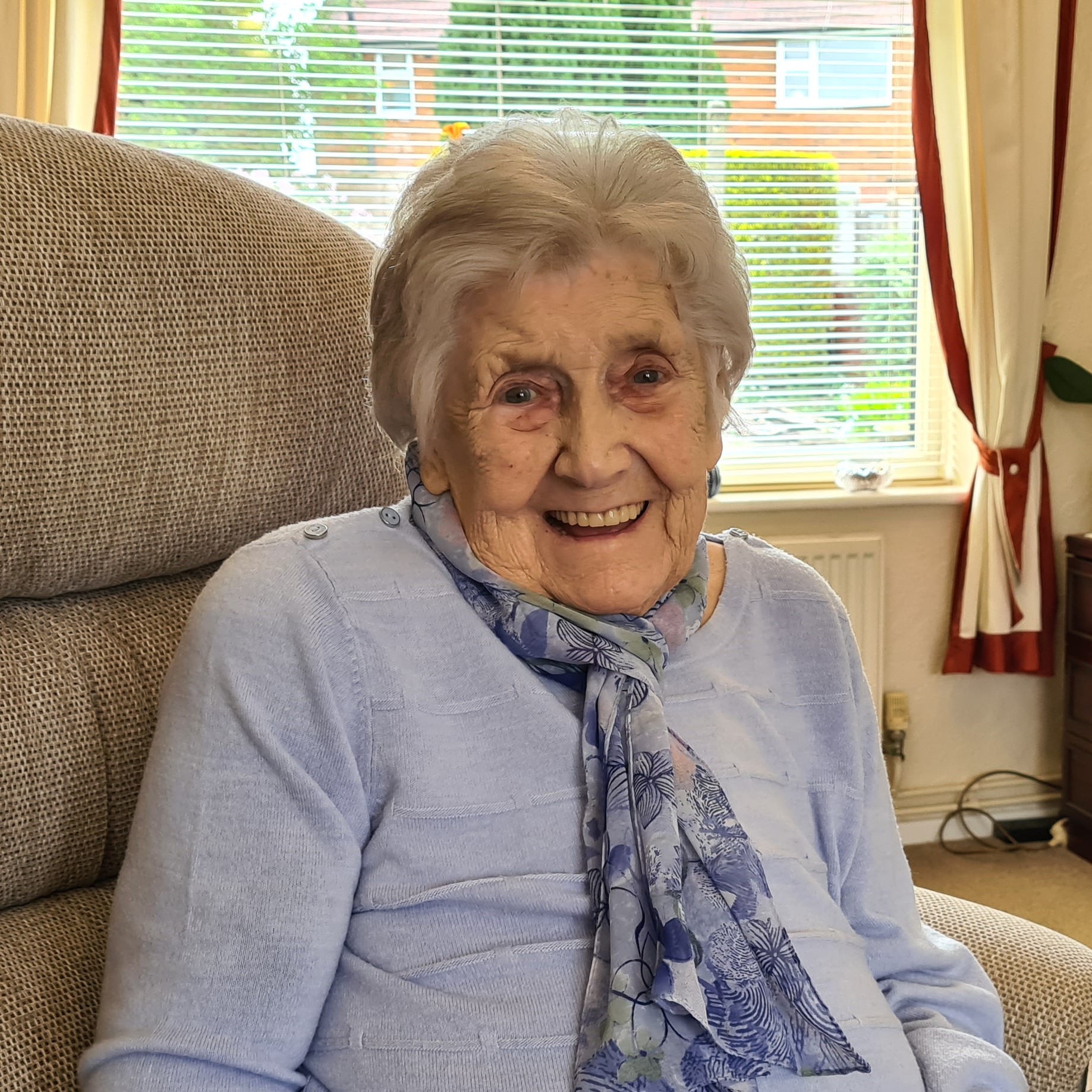
EDIT 27 February 2023
This is a record, sourced from the Bundesarchiv and kindly provided by Markus Kalina and used with his kind permission.
It is about his grandfather, Anton Naumann who spent a few days as a Prisoner of War at Glen Mill after the war and on his way back to Germany from PoW camps in the USA (he was taken prisoner at Metz, one assumes by the US Army).
It is copied here to show the route of a German PoW being processed through the system, from capture to repatriation.
I am also adding it in the hope that someone might be able to provide Markus with information about his grandad, Anton Naumann. It’s a long shot but sometimes people see things on here and are able to contact relatives via these pages. Please email me (see contact page for address) or leave a comment on this page if you have any information.
– Naumann, Anton, DoB 22.01.1914 in Aschbach –
P.O.W. numbers
USA: 31 G 727 698
Engl.: 732249
Dates in MM/DD/YYYY
11/20/1944 POW, captured in Metz / France
11/30/1944 Camp 14 Coudray (Chartres) / France
04/05/1945 transferred to the USA
04/21/1945 Camp Clinton, Mississippi
04/22/1946 transferred to British custody
04/22/1946 Camp 176 Glen Mill Camp, Oldham, Lancashire
04/26/1946 Camp 90 Friday Bridge, Wisbech,
no date Cambridgeshire Camp 1BG Berechurch Hall, Colchester, Essex
11/25/1946 returned to Germany
251 comments on “Glen Mill Prisoner of War camp, Oldham, Lancashire”
Leave a Reply Cancel reply
Image Information
-
Full Size: 3008×2000px
Aperture: f/8
Focal Length: 18mm
ISO: 200
Shutter: 1/125 sec
Camera: NIKON D40

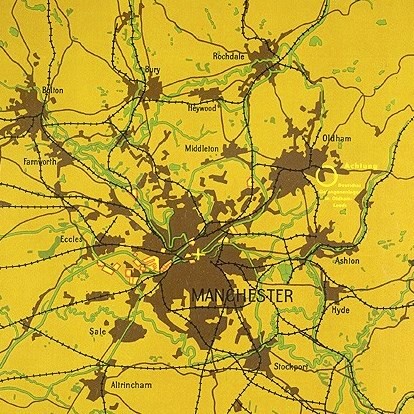
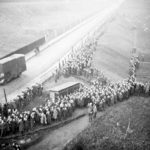
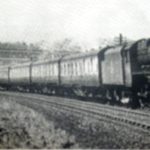
Incredible – I had no idea about this Ian.
For a few years my son lived just outside Oldham. I’ll have to ask him if he knew anything about it.
Great work as always. Rob 🙂
Cheers Rob, great to see you here!
I have lived all my 30 years of life literally 2 streets away from this place and never knew it was once a prison of war… the stories are fascinating and thank you for putting all this together!
Thank you Mo,
I’m happy you found this website and discovered a bit of local history. It’s surprising what stories there are, all around us.
Best wishes for 2024,
Ian
I am, again, super impressed with how this site gives the perfect professional finish to all the dog-work, research, reading, referencing and compiling that is behind an amazing account such as this. The easy read layout, easy view picture stream and ability to link relevant or similar info is fantastic.
This story itself is both typical [POW events] and amazing [6000 prisoners .. and yet over time the history dissipates and dissolves all recognition of it ever being there!]. That you visited in winter, seems to add to the bleak nature of POW life, that concept further enhanced by the bw photos provided.
A great ‘awareness’ post, done well and for posterity.
Lovely comment Ang, on the site and this presentation. Very much appreciated, thanks.
Ian
Great info on this site , I had a look at it about a year ago and only found the pill box you pictured , but I do have a tankard which was given to the commanding officer of the camp by the guards when it was to be closed
Hi David, the tankard makes up for not finding much!
Hi I am from Oldham and the stone pill box isn’t a real box used during ww2 as a young lad I remember there being 2 maybe 3 brick built pill boxes with the slit openings overlooking wellyhole Street I am not sure why or when they were removed but whoever allowed that to happen should be disgusted with there actions we played in the boxes in the 1980s if you traced the river Medlock back towards Strinesdale built into the hillside where 2 very large shelters again brick built but with 4 rooms approx 5 Mt x 5 metre big again unfortunately these to were demolished I remember reading a story of kids finding German buttons/uniform insignia around the edge of a pond near Glenn Mill I’m unsure when this was but it’s always intrigued me to think if anything else was hidden in an attempt to hide belongings from guards lastly it would of been interesting to know if any prisoners saw or heard the V1 which passed over Greenacres cemetery minutes before falling on houses on Xmas eve killing numerous people and flattening a row of houses
Hi,
I’m always interested to read people’s stories about Glen Mill.
I too used to play in the pillboxes back in the 1970’s. I’m saddened to hear that they have been demolished.
My Grandad was in the Army and stationed abroad throughout the war. When he returned home, which was about 12 months after cessation of hostilities, he said that there were still German prisoners of war at Glen Mill, still waiting to be repatriated back home. He said that during the day they were allowed out of the camp and allowed to walk the streets. One day he got chatting to a group of German soldiers and as a result became friends with one of them. He was called Willy. Both had fought on opposite sides and yet became good friends.
Eventually Willy returned home to Germany and he kept in touch with my Grandparents. He and his wife had a son around the same time that my father was born and they used to exchange gifts with each other. Sadly, they lost contact with Willy and his family and my Grandparents always suspected that it was as a result of the Berlin Wall going up. I think my father still has some of the letters from Germany.
I wrote about Glen Mill in my book Oldham Discovery Walks, as one of the walks goes past the site of the old POW camp.
Best regards,
Chris
When I first skim-read the title I thought, ‘they named a prison camp after Glenn Miller? How bizarre’, then re-read it and realised my stupidity, had a little chuckle to myself and wiki’ed Glenn Miller – died, missing in action, when his aircraft disappeared in bad weather over the English Channel as he was flying to entertain US troops in France. I had no idea.
great to read about Glen Mill as I have been trying to find my fathers history he was a guard there at the end of the war.
Pleased you found what you were looking for Loraine!
Ian.
Hi Lorraine. Was interested to read your father was a guard at Glen mill at the end of the war. So too was my Grandfather Jack Schofield! I don’t often come across the history of the camp too often, so was pleased to find this website!
Jacqueline M Hale
Hi Lorraine my father in law was a POW at Glen Mill IN 1942. I realise you posted back in 1914 to say your father was a guard at Glen Mill. I’ve would like to know if there ever was a registration list of prison names? Any info you may have would be appreciated.
Hi Angela
Sorry not sure not really investigated it ,there are quite a few people comments on geans reunited. May be that may help you .
Hi Loraine,l dont know where you are from but there is a Local Interest Centre in Oldham where they have a lot of info on Glen Mill when it was used for POW.They presently have a display in the local market hall that has some great pics and info.
Me now 70 years old but seem to remember my father telling me about a local character called ‘Jock Kirby’ who was reputedly a sergeant over the guards at Glen Mill, a typical tough looking bull of a man, Who, when the local lassies threw chocolate and gifts over the barbed wire at Christmas time threatened to shoot any prisoner who picked them up! then went and collected it all and distributed it to the local children.Indeed some of the prisoners did not go back to Germany after the war but stayed in England and married local girls.
Indeed they did Charles! Bert Trautmann – who played for Man City and who died only a few months ago – being one such example, he was at a camp in Ashton.
Thanks for adding your Dad’s memories of Jock Kirby, I love it when people add details like that to these stories.
A colleague at work was telling me the other day that a member of his family recalled that when there was an air raid over Oldham (see the Air raids and Bomb Sites section; Oldham had plenty) people would feel quite safe near Glen Mill because the Luftwaffe would do what they could to avoid bombing the area.
Ian
Hi Ian,
Bert Trautmann was a prisoner of war at Ashton in Makerfield between St. Helens and Wigan. I say this just in case people think it’s Ashton under Lyne. Before signing for Man City, he played for St. Helens Town F.C. (Not the Saints though!)
Regards, Sue
Is that right? I never knew. I probably thought it was Ashton under Lyne! Thanks Sue.
Hi I read somewhere that the germans got Leeds and Lees (the area in which Glen mill was situated) mixed up I also read of a girl witnessing the V1 flying over the cemetery opposite Glen mill on xmas eve I wonder if any of the POWs saw it I imagine they would of heard the explosion as it landed only 1-2 miles away
Hi Stephen, the Luftwaffe map above gets it wrong, refers to Lees as Leeds!
I lived in Lees in the 1960’s and 1970’s and remember the mill very well.
I lived in Turner St and you could see the mill from my bedroom window, at a good pace I could be in the grounds in 4-5 minutes.
The mill was derelict but in sound condition and us kids used to go ‘exploring’ there quite a lot, it was very big, very empty and extremely spooky.
At this time there were still several ‘Pill Boxes’ near the mill perimeter and on the opposite side of Wellyhole St across from the mill was the ‘cooler’ building containing cells for naughty prisoners.
I remember the mill and chimney coming down in the 1970’s to be replaced by what seems to be a forested area along the path of the Medlock.
Quite a few German POW’s from the mill settled in Lees and Saddleworth after the war.
Thanks for adding that Peter. Am quite envious, as a kid I would love to have explored and played in a place like that…
Never mind ‘as a kid’; I’d like to do it now!
It’s a shame most of the mills have gone. 25 years ago wherever you looked there were mills and chimneys in every direction but they are a rare sight now.
Where would be this “cooler” building be Peter? l lived just off Wellyhole from 1958 to 1969 when they were being demolished,but can’t think where this must have been unless its where the Nuffield Centre was.
Hello Patricia,
The ‘Cooler’ was a single story blockhouse type building on the opposite side of the road to the mill.
It was past the Nuffield Centre (but on the same side of the road)and from the outside it resembled an above ground air raid shelter in red brick.
Inside the cell partitions had been pulled down but the individual barred windows of the cells were still there and it didn’t take much imagination to see what the original purpose of the building was.
I was told of the purpose of this building by the father of a school friend who had been a prisoner at the mill during the war and who settled in the village afterwards.
Thank you for your reply Peter.l know where you mean now.ln fact there was another one just behind that one further up the hill.
Was there any footage of the mill and chimney coming down Peter?I lived on Wellyhole st.50s and 60s leaving in 1970 when the houses started being demolished.
The Germans may have marked the Glen Mill on there maps, but they still bombed the area. Across Lees road at the bottom of Wellyhole Steet is Breeze Hill Road and about 100 feet up the bank was a bomb crater. I was told by my father who used to live at the end of Breeze Hill Road and used to walk by the crater every time we went to see my grand mother, this was back in the early 50’s. When I was living off Huddersfield Road in Waterhead, the next door neighbor was a German sailor who had been a prisoner at Glen Mill.
I’m sure. Given the air raid on Oldham of October 12 1941 when 27 people were killed in less than two hours it would be expecting too much of any bomber crew (certainly at that stage of the war) to be able to avoid a small specific area.
Thanks for adding that detail Doug. I wonder if your German sailor neighbour had been on a U-boat? A lucky escape for him if so – something like 75% of all 40,000 U-boat crews were killed in action.
Ian
https://aircrashsites.co.uk/air-raids-bomb-sites/then-and-now-oldham-13th-october-1941/
Hello Doug I guess your second name is Charnley and that your mum and dad wher called Bill and Agnes if so they were my god parents as I am the son of the sailor who lived next door to you at spring hill,you told me off when I was little for playing with your model aeroplanes sadly both my parents are dead now but that’s just life hope you and yours are o.k.
Hi Kurt Sorry about my tardiness in replying forgot to click the notification button. Yes my mother and father were Bill and Agnes. My parents are dead also. Your dad used to make a great burger with onions in fact I can still taste them. On FB?
Hi Kurt,
Am I correct in thinking that you are the son of Ann and Egon Heckerman? Your cousin came into Oldham Local Studies back in about 2008 after I requested any information on the Glen Mill POW Camp in the Oldham Chronicle and the Oldham Advertiser. Quite a number of people came to give their stories and memories of the camp. The display boards are still available to see as are the transcriptions of the people who contributed to the exhibition at the Local Studies and Archives which is at 84 Union Street, (the old post office building. We look forward to seeing you,
Sue
HI SUSAN, sorry I have taken so long to get back to you but I only visit site every now and then as Oldham does not hold very many good memories for me but was nice to read your comments if you want to contact me feel free.kurt
Hello Kurt how have you been. It’s been over 27 years since we last spoke. I’m one of the twins if you have a Email address it would be nice to have a catch up
Hi Deborah,yes 27 years is a long time don’t get on this site very often my email is myprickelyhedgehog@gmail.com if you want to chat,dont know if you are in touch with Julie but she left a message on this site but as I don’t visit very often only just got it.well will say bye for now as I am just about to go to work hope all is well with you and yours and if we don’t speak have a merry xmas.and a happy new year.
Kurt or is it Richard now can you contact me regarding dad and house on smith street Julie
hi Julie been a long time only visit this site now and then if I can help what info are you after.
The sailor was my Grandad and Anne my grandmother, I unfortunately never got to meet them, amazing how I just came across this Wow
Hello Kurt, I believe you are my uncle, am I right that Karl is your brother, he marred my mum Gail, and they had myself and Paul, hope to hear from you, maybe not as so long since post was up
hi Nadine yes I am your uncle and karls brother although I have not had any contact with him for over 28 years in fact it was our fathers funeral.nowt so queer as folk,i used to look after paul and yourself when you where tiny I can still smell the nappies lol.
Hi Kurt,
I was spending a lazy afternoon during lock down looking at bits of my childhood history. Long story short, I remember the Glen Mill very well.
I went to school with or certainly played with a Karl Heckermann, the family lived in Waterhead near the Cairo Mill, know as the “Mill Bottom”.
If it is your family I did meet your Mum and Dad on at least one occasion.
To be honest it was a very long time ago, probably back in the early 60’s
Kind regards
Pete
Hi Nadine I hope you read this I notice your email was dated 2015 . I went Derker Seconday Modern School in Oldham and your Dad Karl was in my class he was such a nice lad and I remember him well.I am sure as I recall Karl’s Mum your Grandma Anne had a hairdressers shop in the 1950’s in Waterhead. I remember going with my Mum when she had a perm and was fascinated by the machine your Grandma used , it was like something from a sci-fi movie . My Mum knew your Grandma well she was a lovely lady . When we left school I never saw Karl again but I often wondered what happened to him. I don’t remember your Uncle Kurt though . Please give my best regards to your Dad . Kind regards Olwyn White ( nee Mayers )
Hi I’m Karls step sister , his dad married my mum in the early 70s , sorry but Karl died in April 2019
Sorry to hear that Julie, but thank you for letting us know.
Ian
Karl was on U-boats and from what I remember gave himself up at he first opportunity.
I compiled a small exhibition regarding the Glen Mill POW camp a few years ago. The display is available to see at the Oldham Local Studies and Archives, 84 Union Street, Oldham, tel: 0161 770 4654; opening times can be found on our website:
http://www.oldham.gov.uk/info/200276/local_studies_and_archives
A number of people talked of their memories and of the friends they made of the prisoners. Their reminiscences are available to read also.
One prisoner, Kurt Geiger, donated a large folder containing letters he sent to friends he made in Oldham after the war. He visited the Local Studies in the 1990’s.
Sue Smith
Thanks Susan, sounds interesting, next time I am in Oldham I shall take a look at that. Is it a permanent exhibition?
Hi Susan Do you have any of your exhibits online that way us Oldhamer’s who live out of the country, cannot jump on a number 98 bus and pop in and have a view of what is on display.
Dear Doug, thank you for your interest in the Glen Mill. Unfortunately, the small exhibition is not available online we’ve not yet got around to publishing exhibitions on the internet, but who knows, when we open the new archives building things may change.
Regards Sue
Carlo Depotrillo the barber on Middleton rd Royton, his grandfather was an Italian P.O.W. at Glen mill, I worked with Geovarni(John) on Oldham Buses, he cam to Oldham because his father said, Oldham people are the friendliest people on Earth and if he was comming to England he had to come to Oldham.
Thanks Colin. Probably the warmest recommendation for Oldham I have read! My memories of Oldham are not that friendly; away at Boundary Park on a cold December evening being beat 4 nil.
: (
I. Used to work and lodge with a Karl Leir. At broadband farm watersheadings, He had married Mrs Tounge (widow) she had a son called David, we all worked window cleaning in oldham. Mills shops houses. I used to clean all the shops on union still on Saturdays. Before they opened. For business. Karl was a prisoner of war at glen mill. Glen mill used to make foam rubber in the 50s.
Hi Eric, thanks for your visit and memories.
Your site as regards Glen Mill i am doing a project for a lady who work on the site when it was a training centre as is very keen in finding more about it.
Hi Ian ……….
I posted part of this on the Abbey Hill Road bombing site.
I lived on Kingsbridge Road until 1951, then we moved to Waterhead and lived not that far from Glen Mill.
I went on a Counthill Grammar School ski trip to Kitzbuehl in Austria over New Year 1956/57.
It turned out that our ski instructor (an Austrian) had been a POW at Glen Mill. He must have been around 34/35 at the time that we met him
He asked us all kinds of questions about Oldham “now”, as he had very fond memories of his time in the camp. He had been only too glad to be captured, and sent to England. We tend to forget that many of those men were unwilling conscripts.
He mentioned a local lady who used to invite 2 or 3 (or 4) POWs to her house for afternoon tea, usually on a Sunday I think. I remember that lady, though I cannot now remember her name ………….. but she was much reviled at the time for being friendly to “those men”.
He also told us that the men had built a tennis court at the Mill, so that they would have somewhere to play and get exercise. He wanted to know if the court was still there, because they had built it with such care and to last.
None of us felt like telling him that it had been demolished ………… so we lied, and told him the court was still there and still in use.
He was so glad to talk to people from Oldham that he spent all the evening of New Year’s Eve with us.
It’s great that you recall the ski instructor from Kitzbuel. Again your memory of what he told you is sound, many PoWs were gradually allowed out and into the community and had tea with ladies, perched on the edge of the settee, nervously sipping their tea. But fraternisation beyond that was not allowed – staying over or having romantic relations though it happened of course.
Near where I live in Bury there was outrage when German PoWs from a nearby camp were allowed to join in the Christmas Carol service that year. I think Italian PoWs were better accepted, though the ones in Bury were not popular with the men because they WERE popular with the girls! But yes, many were invited into people’s homes for tea as a sort of rehabilitation. Please see the photo of Warth Camp and Burrs Camp for more on PoWs in the Bury area.
I smiled when you said you didn’t want to hurt his feelings by telling him the court was still there. I would like to think I’d have done the same. I recall my dad, who was a sailor during the war, telling me about how some PoWs they captured from a U-boat made a provisions net to occupy themselves and how it was a shame that they never quite finished it because the work they did was of such quality, proper ropework he said, an old and respected naval tradition that had nothing to do with Nazism.
Lovely to hear from you Sylvia, thank you so much for sharing your memories, of the V1 on Oldham and of your ski-instructor when you were a schoolgirl. Good to get all this stuff down. It was long before my time, but I love finding traces of the war and recording them and memories such as yours.
Ian
My Grandad Samuel Chapman was a CQMS in the Pioneer Corp and a Guard at the Camp being aged 51 at the time. Sadly, in Sept 1943 he suffered a heart attack in the Mess there having just returned from leave from home in Liverpool He had a funeral at Bootle Cemetery and notice in Walton Times states floral tributes from No.2 Guard Glen Mill Camp and Lieut Col H A Dennison MC and Officers at Glen Mill Camp. Can send photo and scanned article to anyone who wants the them for record.
Hi Alan,
Thank you very much for your comment. I’d be happy to include a copy of the article and photo in this narrative if you wish, the more history we can preserve and present on the internet the better. My e-mail address is here
Ian
I would appreciate the photo etc you mentioned.
Best wishes
Frances Bradburn
Hi Frances, which was the photo you refer to?
Ian
My dad loved this story. He was a small boy during the war. He is currently in a respite home in Lees and on a short walk a local told us about Glen Mill and shared his memories. It was lovely being able to share your story with him.
Thank you.
My father’s name is Arnold Hill. Born in Newton Heath.
Hi Tracey, thank you very much for writing and for showing this page to your Dad.
Please pass on my regards to him.
Ian
I will. He’s asked me to find out more about Glen Mill. As a young girl I loved his stories about the air raids and looking for shrapnel. His sister (still alive too) used to date a yank, today dad recalled his full name.
The assistant at the care home is going to do a memory session on Glen Mill with it being local.
Look what we’ve started. Lol
It’s all good, great to ask that generation to tell us their stories. They have been with us all these years but even those who were kids during the war are in their 80s now.
I am in adult social work, whenever I get the chance to ask people what they recall of the war I always do. People tell me all kinds of stuff; a WAAF from London who was also dating an American, she took a joy ride in a Flying Fortress bomber (the type in Memphis Belle). I wanted to know more, but she hated it, she said the smell of the engines made her sick and she fell out with her boyfriend over it! In Oldham I once met a man who was with the South Lancs Regiment, he was one of the first ashore at Sword Beach on D-day. He couldn’t understand why I wanted to shake his hand!
Yes it would be good if the care assistant at the care home does that. She can get them to add their tales on here if they want, then there’s a record of it somewhere. Can easily ask the people contributing whether they want to remain anonymous or whatever.
When I was a child living in Oldham, my parents used to give a Christmas dinner to 2 German POWs from glem mill. That would be around 1942/3. They used to bring a small gift. One was a letter opener made from old plastic tooth brush handles. Very colourful !
Regards
Frances Bradburn
Hi Frances, thanks for your visit and comment. Interesting to read of the rehabilitation of German PoWs and of your parents’ attitude; great they were willing to share Christmas with them. It was an enlightening idea, having the enemy visit people in their homes for a cup of tea or a meal.
Is there such a thing as a list of POW at Glen Mill ? If there is – how do I access it ?
Thank you
Frances B
Not that I am aware of Frances. I have been asked this before and it is very hard to find info about PoWS.
This National Archives guide might give you some ideas but it’s notoriously difficult to trace individual men.
http://www.nationalarchives.gov.uk/records/research-guides/pow-displaced-persons.htm
This page about Glen Mill PoW camp is viewed often so someone in Oldham may come along who knows of something?
Hi Ian and Frances.
I could not find a list of POW’s from the Glen, but there is a possibility that there may be a list held by the International Red Cross. It was their job to visit POW camps run by the allies and the axis countries and they also reported on the conditions of the camps and made sure that the prisoners received their letters and parcels.
Regards, Sue
Hi Sue, good to see you again, and thanks for looking for the POW lists for Frances.
Ian
I was born under there shadow of the glen mill in Roman st one of the adjacent street to Wellyhole st and Constantine st ( the local name for Constantine st was the “bunk ” and still is as far as I know?) wether or not this from the guard bunkers on the side of Constantine st overlooking the millI can’t tell but I lived there from ’49 to ’53 and returned to live in Wellyhole st in 1965. The mill was used after the prisoners of war had left by a company called Vitafoam that made some of the earliest English made aerated or expanded foam for various uses. My father worked there for a while as did my cousins . My earliest recollections of the Mill was playing Games on Empire day on the adjoining croft with both the soldiers and the inmates,We would play leap frog in teams and foot races with the Mill in the background . As I was born in ’49 the POW would have been waiting repatriation .
My earliest visual recollection is of the mill chimney that (what looked like from the ground and some distance away ) had a brick missing right at the top rim said to have been knocked out by lightening? On reflection now it must have been a lot more than just one to be seen from the distance of Roman St.
You will probably know my cousin Jack Gough,Alan.He was born in 38/39 and lived at my grans on Egyptian st.up to getting married in 1963.I remember her telling me about the prisoners being marched down Wellyhole st and across Egyptian st.down Stanley brew into Lees and surrounding area’s to do various jobs.My mum also worked there when it was Vitafoam and when l sometime’s went to meet her,had my first encounter with a black person.
Hi Pat ,
No, sadly I don’t remember Jack Gough though the name is vaguely familiar ? Tommy Car was a guy I remember from Egyptian street we called him Uncle Tom . Big fat bloke as i recall ..but then to a 3 y.o …everyone is big and fat …lol …I do remember the inmates going down Stanley brew and also down Wellyhole st .
After the war they where liberated and allowed just about anywhere so where around quite a bit . My father used to tell me some didn’t want to go home .
My fathers name was Jimmy and my grandfathers to ..My cousins ( still alive Jeff and June Kay ) all from Roman st
Hi Alan,It’s been a while since our last chat,and even though l try to read some of the updates l have only just seen your msg.There has been quite a bit of activity of late and called in for a catch up.Glen Mill was a part of our childhood,but little did we know all the secrets it held from us then.I wanted to let you know that your family is mentioned often by my 2 elderly neighbours who also lived on Wellyhole and Roman st.One is Trudy Costello and the other is Brenda Greenhalgh who l think lived next door to you on Roman st.I will mention having seen you on here when l speak to them.Hope you are well.
Thank you one and all for the information you have provided. I have emailed the I Red Cross. Any further information I get will be shared on this website
Best wishes
Frances Bradburn
It was very interesting reading your article about Glen Mill and seeing the photos. As a young boy I used to play in the Pill Boxes which ringed the site.
My Grandfather served in the Lancashire Fusiliers throughout the war and when he eventually returned home POW’s were still housed at Glen Mill until they could be repatriated. During this time they were allowed out of camp to walk around the area. One day my grandad and my grandma’s brother, who had also served away in the war, got chatting with a small group of German soldiers. My grandfather and one of the Germans, who was called Willi, became good friends and he would call at my Grandfather and Grandmothers house on regular occasions.
When Willi was able to return to Germany, they kept in touch by letter. Willi and his wife had a son around the same time that my father was born and my grandparents and Willi’s family would exchange gifts for each others sons. One such item that I always remember as a child was a hand-carved wooden canoe with an American Indian sat rowing. It had been sent as a gift for my father.
Eventually my grandparents lost contact with Willi, which they always believed was the result of the iron curtain being drawn across Germany.
This story which my grandparents told had a significant impact on me. These young men (my Grandfather and Willi) were soldiers who, not long before, had been on opposing sides and had seen bitter and bloody fighting, and yet after they had laid down their arms, became true friends. It is not the common man who sends us to war, but those in positions of power and influence who have much to gain from sending men into the arena of conflict.
As the author of a local book named Saddleworth Discovery Walks, I am now working on a new title which will explore the history and heritage of Oldham. One of the walks in my next book passes the site of the former Glen Mill POW camp, the history of which I will be including within the pages, in order that younger generations will know of the camps location and history.
Once again, thank you for posting the information and photo’s, which are of great interest.
C. Maylor
info@saddleworthdiscoverywalks.co.uk
Hi Christian,
Thank you for visiting and for your comment.
These stories of friendships springing up between the Pow and the public are very common. It is a phenomenon of the war between Britain and Germany, that respect for the individual if not the nation or the politics they represented. For example, my dad served in the Royal Navy during the war, he saw the Hood blow up and sink in minutes with the loss of all but 3 sailors on board and saw his mates killed in battle yet married a German woman shortly after the war’s end (not my mother, his first wife died in the early 1960s).
I am reading a book now about British sailors in WWII, and have just read an account of the destruction of a warship, the British determined to sink the ship. But when the German survivors were struggling to swim to the British ship, one RN sailor risked his own life and jumped in fully clothed to assist his enemy in the water! My dad used to say he hated the Germans in battle, he wanted them dead. But when they were prisoners on his ship, he had respect for them and had a laugh with them. Allied air crews often said the same.
Anyway thank you very much for your memories, great story about Willi. Best of luck with your book. We may have taken this history for granted all our lives, but that generation has now nearly gone and what physical remains there are on the ground will lose their meaning and relevance if we don’t write about them!
By the way, I take it you know of the various air crash sites around Saddleworth? There are half a dozen or so on the moors above Oldham, most with some wreckage remaining. Let me know if you need any grid references.
Ian
Hi Ian,
Thank you for your reply to the info which I added to the site back in October 2014. How time flies. It’s been some time since i last visted the site, but today thought I’d have a catch up. It’s nice to see more info and stories are being added all of the time.
I completed my second book, Oldham Discovery Walks, last Christmas, in which I included a walk which passes the site of the Glen Mill POW camp. I gave the camp a mention in order to document it’s existence and let people know where it was sited.
Thank you for the offfer of providing grid references for some of the crash sites on the moors around Saddleworth. I’m aware of some but it’s always useful to have info about others. I’d be very grateful if you are able to provide grid references and any information which you consider useful.
I’ll try to follow the comments on this site more regularly in future, as it’s a wealth of interest.
Thanks again and best wishes,
Chris Maylor
Hi Chris, has it been two years already? Blimey. Yeah, the readers of this page in particular do provide lots more info about Glen Mill than is recorded in history books and elsewhere, personal accounts are unbeatable.
Re; crash sites, I will get some grid refs to you soon.
Best wishes,
Ian
Sorry. Think I sent this email re photo to the wrong person.
Best wishes
Frances Bradburn
No worries Frances!
Ian
Thank you for that Frances, I hope they will be able to provide names. I think we all look forward to hearing from you soon.
Sue
Sadly – no joy from IRC re queries about POW @ Glen Mill.
I will persevere with my research & hopefully get the information I am looking for.
Thank you
Frances B
Thank you for trying anyway
Sue
Hi Ian
I have been searching the web for information about German POWs. I’m writing a novel set in the UK in the 1940s. Do you know when POWs started working on farms etc,? When I came across your site I got excited since you give interesting facts, but it seems those prisoners you write about stayed put! I will continue to do a search,but if you have any knowledge of when prisoners actually worked I would appreciate it.
Sincerely
Mary
Hi Mary,
I shall also take a look at the books I have to try to determine when German PoWS started working in public and get back to you.
I think the answer is around 1941 after the threat of invasion had passed and it also depended on the strength of the political conviction of the inmate and their escape risk. There are a couple of other stories in this set (Britain at War) about PoW camps which may help.
I also think Italian PoWS had more chance of being able to work outside the camps than Germans but that may just be with regards the particular stories I have researched. You will know of course that the further north the camp, generally the higher risk grading for the prisoner, though it won’t have been as clear cut as that I’m sure.
The details you need then are a) when and where German PoWS worked in the camp; b) worked outside the camp with supervision; c) worked outside the camp without supervision?
Ian
Hi Ian
Thank you for your prompt reply. That is so kind of you. Yes your last sentence captures what I would like to know.
I have done quite a bit of research and have a file to prove it. But the background story has to be correct even though the characters are fictional.
Thank you again
Mary
Hi Mary,
I was going to send this as an email but the details may be of interest to people reading about Glen Mill so will post it here.
The dilemma the government had was the need for labour – v – breaching the Geneva Convention (PoWs could not do work contributing to the war effort) / the risk of escape / upsetting the people of Britain.
It does seem to be the case that Italian POWs had better chances of being able to leave the camps and had more freedoms, especially after the Italian surrender in September 1943.
However, you ask about German POWs not Italian PoWS. I have struggled to find evidence of German PoWs being able to work off-site before 1945. There are numerous references to German PoWS working on farms etc from April 1945.
Before 1943, there are references to the majority of German PoWS being shipped (against their will given the risk of U-boat attack) to North America for security reasons.
Where PoWS (Italian and German) were allowed off-site, they were subjected to rules which gradually eased during the post war years to 1947 by which time one source says “around 250,000 German POWs had been repatriated, but 24,000 decided to stay in Britain.” The rules included not being allowed to travel on public transport, not having currency, going in pubs and restaurants, not attending football matches, not staying out overnight, not fraternising with British women etc. The reports from people on these pages whereby German PoWS were invited to have tea with civilians appears to be a post war scheme.
Best resource, you will have seen this already I expect, says;
“They would then be sent to various camps around the country and for the fervent Nazis this would sometimes mean a camp in the wilds of Scotland where they would be put to agricultural work on farms…
Every prisoner could work if he so wished and would usually be detailed to do farm work, which would involve hedging, ditching and harvesting, construction work or clearing bomb damage etc.”
It should be noted that ‘bomb damage’ work is likely to refer to work later in the war or after the war, certainly not during the Blitz years.
It continues, “During their working hours they would (if working on farms) be under the direct command of the farmer to whom they were employed. Construction work was also carried out by the prisoners as within their ranks were tradesmen who before the war worked in the construction industry. In Britain at the time there was something of a housing crisis due to the recent bombing campaign by the Germans and it was estimated that 4 million homes were destroyed which would have to be replaced.”
That same website also has reference to some resistance tactics by the German PoWS at Glen Mill though as mentioned it also refers to some PoWS escaping and making it back to Hamburg which I believe is inaccurate. Source http://www.radiomarconi.com/marconi/monumento/pow/pows.html
Another source says that “381,000 German POWs were employed at peak in summer 1946 in Britain” representing 2% of the British workforce and 10% of the rural labour force.
However in and among all the anecdotes I have referring to German PoWs one from Christmas 1944 is reported on these pages, with a lad recalling the name of the German PoW he had befriended and a conversation he had after a V1 Flying Bomb had landed at Radcliffe;
“Lots of us kids were there. The night before, I heard the engine cut out as it dived down. I told my friend, a German POW about it. His name Otto Adler Luftwaffe guy about the v1 He grinned and said. I think you would have liked it to land on your school. TRUE.
V1 at Radcliffe
To summarise and from what I can gather having looked at the books I have which refer to the scene in Northern England and nationally are;
a) Most German PoWS chose to work but officers could not be forced to work and most of that will have been in and around the prison camp. They could not do ‘war work’ but then all work was essentially war work.
b) There is some evidence of German PoWS working on farms before 1944/45 in Scotland but not much. Evidence that before the invasion of Normandy, German PoWS were shipped to North America where they did do some work. The IWM photos above clearly show PoWS working outside the Glen Mill prison camp early in the war, though they appear to be under armed guard.
c) After 1945 a great deal of evidence of German PoWS being taken to farms, working under supervision of the farmer, then returning to the prison camp at the end of the day, with restrictions easing over the post war years and many choosing to stay on in Britain and settle down, or, as many people have said on here, father children but move on.
diary of German PoW
Hitler’s Last Army: German POWs in Britain by Robin Quinn due for publication in a couple of months which looks interesting. Mr Quinn may be able to provide you the exact details you need?
Below; German PoWS, Devon 1946

Hello Ian,
You are so kind. Thank you for taking the time to find and give me some interesting information and leads. I shall explore them all.
God bless you
Mary
Pleasure! Best of luck with the novel Mary.
Ian
Hi Ian,referring to your post above,re workers etc l have been given a story today from my elderly neighbour.I believe the person in the story to be Otto Adler that you mention in said post.We have another elderly neighbour Elsie,in her 90s who lives across the road who this story is about.Around 44/45 Elsie as a young child,living with her family in the cottages next to what was once the Welcome pub on Abbeyhills rd.(don’t know if it was there at this time)Across the rd at the end of Alt Lane,the German POW used to wait in all weathers to be picked up by trucks after working at the local farms.One day Elsie’s mum sent her across the road with mugs of hot tea to warm them up,showing compassion.When they watched from their window they saw the men spitting out the brew! Shocked and upset thinking they were being disrespectful and ungrateful she vowed not to do it again.Till someone alerted her to the fact that they were spitting out the tea leaves that they weren’t used to.I believe that Otto was part of this group and built up a friendship over decades,each visiting the other after the war had ended and beyond.I want to speak to Elsie of her stories,but she has not been well of late and not sure if she would be up to it,but when l can catch her son l will test the waters and see what he says.
That’s a great story Patricia, thank you for adding it here! It would be great if Elsie was able to provide some memories, I think that is the sort of thing Ben is looking for. Either way, I hope she regains her health.
I was reading in a book called Hitler’s Last Army – German POWs in Britain by Robin Quinn of how the camp at Glen Mill had a problem with rats. The guards offered the POWs 5 cigarettes in exchange for every rat caught. One of the inmates noticed the camp guard simply chucked the dead rat on a rubbish tip. It wasn’t long before the inmates cottoned on, and grabbed the dead rats from the rubbish tip to claim another 5 cigarettes!
Hi Ian,Thank you for your reply.I like the story on the rats,needs must l suppose.As a little update on Elsie’s story from my neighbour,she was actually a teenager when the “brew” incident happened.She got to know Otto a few years later when she married her husband who also worked the farms the POW worked at. He came back from working farms abroad he was stationed at during his service and got work locally.They all used to pass where they lived on Alt Lane and got to know them.They did stay in contact many years and when her husband died she went over to stay with him and his family and he came over here and was friends with my neighbour.I have not managed to catch her son yet and check if she is well enough to talk about her memories herself,l am sure it could lift her spirits talking of those days so it is on my to do list.On another note while we are chatting,l have been telling my neighbours of this site and the other day printed off the pictures from Friedrich Fraubose’s book.Mainly because Trudy is Austrian and speaks German and thought it would be interesting to hear her read out the notes added to each drawing.She loved it,but she has a story of her own! When she went to work at Glen Mill when it was Vitafoam,in the 50s,she talked of the toilet cubicles having no doors on and having an eerie feeling.( One of Friedrich’s drawings show this)There were still writings on the walls in German that the English girls wouldn’t understand.Trudy read one of a young 18yr old missing his homeland and wanting to end it all.Another of someone who wrote of his friend having committed suicide in that cubicle.We don’t know if this was the young man in her first tale,but her English friends saw her distress and asked what she had seen.They went to speak to the foreman/boss at the time,and a few days later the walls were whitewashed and doors put on the cubicles.To add to her record,she also met Hitler when she was a young child at school when he visited her area.And when she called in the Local Interest Centre a few years ago,she translated some of the letters that were written in German that had been sent to the friends that had been made in Oldham and surrounding Area’s.Regards,Pat.
That sent a shiver down my spine Pat!
Great that you showed Trudy those images. I wonder if the translations my friend and I did were accurate or could be improved upon?
Be lovely if your neighbour could be made aware of all this, but health comes first of course.
Take care, hope to hear more from you soon and thank you for adding so much to this history.
Ian
Hello Ian,
I’ve spent quite a few hours today following up on the sites you sent. Yes I had visited the ‘radiomarcon.com’ one and have a lot of that information in my file. I’m setting the novel in and around Devon and noticed there were three POW camps there. I Googled Bickham Camp in Yelverton Tavistok, Devon.I submitted a question asking when the first POWs were interned there. A Yahoo window popped up asking for my Yahoo UK & Ireland password. I live in Canada now and have access to the North American sites. I’m assuming you are in dear old Blighty and wonder if you could get an answer to my question.
Hopefully and with gratitude Mary
I will try. Where did you try to ask the question, have you a link to the specific website?
As a boy I was living up the hill from Grotton. On a summers day I looked up to see that two strangers were coming through the gate. They were, if I remember rightly, dressed in brown dungarees with large round patches on chest and back. I think they were Italian ‘prisoners’ out for a walk. They Oldham archives have confirmed that the Italian prisoners were allowed out to work on local farms.
Hi David, thanks for your visit and your memory. Yes Italians certainly had more freedom to get out and about. I was reading one acount somewhere (think it referred to Bury) where Italian PoWS were able to drive vehicles. Think it was in a copy of the Bury Times, a letter from a disgruntled local complaining about them showing off and flirting with the local women.
Hi Ian,
I will go back and see if I can find it. Sometimes I’m reminded of Hampton Court Maze when surfing the internet!
Ok, please let me know, happy to help if I can.
Ian
Hi Ian,
I couldn’t find it! I’ve emailed my question to this site. Will let you know if they respond.
http://www.coleshillhouse.com/yelverton-auxiliary-unit-and-operational-base.php
Egan heckermann was also my dad and often spoke about Glen mill
During the war years my step father William Handley was a hairdresser and used to go into the camp at Glen Mill to cut the prisoners hair his shop was in Lees brook now a hardware shop after the war ended he would open up his shop at 5-00am to cater for the night shift from the local cotton mills coming home ,having walked into his shop from South chadderton. His business carried on in Lees at various premises well into the 60s early 70s he died sometime in the 80s. He would often tell tales of the prisoners and how they made gifts out of bits of scrap metal or wood to sell or trade for extra’s and of his bit of trading in the black market. Hope you find this information of interest . David
Hi David, good to hear from you and thank you for adding to this history.
Ian
Hi David,
It was really interesting to read your little story. It’s good that these tails are documented before they are lost to history.
Thanks,
Chris
Hi I am delighted to note that an archive ref the Glen Mill exists. I was born in 1942, and until about the same time as the Mill was demolished we lived in Greenacres Road. As rather unruly children we played in Greenacres Cemetery, the other end of which was the Glen Mill. So to some degree that was also a playground, and I remember Vitafoam being in residence. My main purpose for writing this is because as I grew up I often wondered why TV never showed any film of the Glen Mill.
In 1976 my job took me to Brazil for 2 years, ensconced in my flat with local TV, I struggled to master the language, trying to guess what was being said most of the time. One evening, during a programme put out by TV Globo, I saw a short piece of film of the Glen Mill. Not having a command of the language I didn’t know the context of the short film. I am convinced it was the Glen Mill, the short film depicted a “Tommie” with rifle, greatcoat and tin helmet standing at a position which could have been a point on the perimeter of the mill lodge with his back to a distinctive flat piece of ground. All other background had sloping features. I don’t know when the Rugby ground was made at that point, but it was certainly there when I was a child. I think the horizontal stripes on the building and the flat land in a background of sloping land suggests to me that it couldn’t be anywhere else. There is a very large German population in Brazil, (including the then President, Guisel). Its not inconceivable that this film originated with a Glen Mill P.O.W.
Hi Colin,
Thanks for your visit and comment. I was very surprised when researching Glen Mill at how little there was about it.
Interesting to read of your time in Brazil. The horizontal stripe is something I have looked for when trawling for photos, it is not that common a feature so you are probably correct. I have a book somewhere on the history of cotton mills, shall take a look and see if there is a reference to Glen Mill, though I probably looked when I did this piece and found nothing.
Ian
REQUEST FOR INFORMATION FROM THE USA RE; WHITEHEAD FAMILY OF OLDHAM
Received this message and a couple of photos from a woman in the US. Please contact me if you may be able to assist, and I will put you in touch.
Thanks
Ian D B
“My late father served in the U.S. Army. I was recently was going through some of his photographs from the war when I came across a page from his time in Oldham, Lancashire.
He had befriended a family with children, and there are several lovely pictures of him with the Whitehead kids. Sadly, it seems Ian Whitehead was killed, along with three other children, when they came upon an undetonated German bomb. Apparently, they were tinkering with it. (He had a newspaper photo of Ian attached to the page, although there is no obituary.)
There is also a notation saying this newspaper was sent to him when he was in France (which would probably be 1944).
My father died last year at the age of 91. He often spoke to schoolchildren about his experiences in the war (he later served in the US restoration government in Berlin), and talking about the children he met, from England to France to Germany, was important to him.
He could never speak of Ian, however, without tearing up.
I am trying to locate the family — it appears there were four Whitehead children? — to perhaps send them copies of the photographs.
Best to all.”
Given the information provided (excellent stuff) by Sylvia and the fact of where the bomb exploded could I suggest you try contacting the organisations I will refer to;
Burbage Good Neighbours
Withington Assist
Both these organisations are part of the South Manchester Neighbourhood Care Groups and support local older people, many of whom are in their late 70s, 80s and 90s. There is a good chance someone will have a memory of these boys or their families.
I am more than happy for you to email me so I can put you in touch. t.annette@manchester.gov.uk
Thanks Tracey.
Hi ………
For those interested in helping find information for the lady from the US, I have had friends help me to find the following ………….
The 4 boys killed were Ian Alexander Whitehead (12) of Errwood Road; William Meare (18) Moorcroft Drive, and Ronald Salt (15) of Errwood Road — all of Burnage ; and Clifford Astall (15) of Withington. A 5th boy Ronald Johnston (15) of Withington was injured.
The accident happened on June 2 1944 ……. the boys had been out hiking in Staffordshire when they found a mortar bomb and seemingly took it home because the explosion happened “in a house in Manchester”.
The only birth reference we can find that seems to fit was for an Ian A Whitehead born June quarter 1932 in Tynemouth, mother’s maiden name Harrison.
One possible siblings could be Alan R Whitehead, born March quarter 1930, Tynemouth …… there are too many Whitehead mmn Harrison born in Oldham and other areas after 1932 to be certain that they are siblings (Whitehead / Harrison marriages are surprisingly common!)
References to the tragedy were found in 3 newspapers, from different parts of England, but not from the Manchester area!
Errwood Road was (is!) in Burnage, a suburb of Manchester, about 4 miles south of Manchester city centre, east of Didsbury village and bordering on Stockport.
Oldham, of course, is about 7 miles north-east of Manchester.
There is no information as to whether Ian’s family had lived in Oldham, or whether this lady’s father met the family in Burnage.
I can’t provide any more help than this …………. but hoped the information might spark a memory in someone else.
Ian ………….. the hope that others may know more than me is why I’ve posted this on here, rather than email you
That’s a terrific bit of research Sylvia, thank you for taking the time to put it all together. Because this page gets so many views from people in or from Oldham and who were around in the 1940s or have knowledge of that period, I thought it might stand a good chance of yielding some results. As you say, all this might spark a memory.
thanks again,
Ian
Sylvia, thank you!
Maria
I’m gathering photos of those involved in 76 Squadron RAF from WW2 and came across this harrowing story. Later in August 44, Clifford’s father, also named Clifford died on operations with 76 Squadron
Hi there, just stumbled across this site, I recently received copies of my late fathers army service records and he was a sergeant at Glen Mill Camp, from what I can make of the records, from 1943 until 1945 when he left the army. Previously based at camp 63, Balhary Estate, Scotland.
No doubt there is no one alive to remember him, his name was Valentine KAY.
Great to know of the display at Oldham Local Studies, and I will make a point of visiting there the next time I am In Oldham
Hi Dave,can you tell me please how you obtained your fathers army service records? We have talked as a family about doing this for quite some time.We tried getting them back in the 80s after his death during a medical case,but were told they could not be released to us,but some could be to the team involved in the case.Sounds like things have changed over the years?
As a youngster I used to deliver paper for Cockcrofts of Salem Brew my round always finished in the cookhouse at Glen mill it was on the right hand side opposite the mill where the prisoners were housed and each morning on leaving I would find something in my paper bag sugar,tea, even slices of meat put there by a German trustee this was before the minimum age for paperboys was introduced and I must have been about12-13
Hi Ron, thanks for adding your memories of Glen Mill PoW camp.
My father was the vicar at Holy Trinity, Waterhead during the war, and on alternate Sundays would walk down to the camp to take a Communion service, the alternate weeks were taken by the vicar at Greenacres. My father lost a leg in the trenches in 1916,and so in bad weather needed 2 sticks, so I would carry the case with his robes, ( in those days the loss of 2 limbs was the minimum requirement for transport). After the war, circa 1970, the camp had been taken over by Oldham Social Services Dept. and was a training centre for Mentally Retarded Adults, my wife was an instructor there. The original buildings were still in use as classrooms and workrooms, one being converted into a bungalow, where they could be trained to live on their own. In those days it was called ‘The Arthur’s and Kenyon’s Centre’. If you need pictures of the buildings, then probably Social Services would be able to supply. I still have in my memory some of the tales that the guards told my father if you are interested.
Hi Gerald, thanks for adding your memories. Happy to have any stories you have about the PoW camp from your dad. It is as good a place as any to record and preserve these stories for a while longer.
Ian
In one of the messages there is a comment about the large number of crashes in one region. During the war, one of the valleys was known locally as ‘Death Valley’. After bombing Manchester, the German planes would be flying low, and were kept at this low altitude by our fighters above them. They had to find valleys to get through the Pennines. Our fighters steered them into valleys with a dead end which they couldn’t see until it was too late, so they crashed.
When I went to Glen Mill with my father, I was considered too big a risk to be allowed into the service, so I stayed in the guard room. Here I was taught how to aim a rifle. They did a good job, a few years later I was on the school’s shooting team.
I knew about prisoners being released on Parole to work on the farms. I would say that was 1943, or maybe earlier. I also knew about the tennis court, and again prisoners were allowed, on parole, to compete with the local ladies, which was appreciated by both sides.
For a short while, an SS officer inhabited the camp, and the atmosphere changed immediately. The other inmates were totally afraid of him. I know that he stormed into the senior German Officer’s office threatening to have him hung drawn and quartered when Hitler captured England, for not ordering the soldiers to break parole and escape. I think that he was removed for his own safety. 5999 to 1 is not much of a chance.
There was a tunnel attempt, but I am not sure of the details, whether it was discovered before or after use. I think that the intention was to come up in Greenacres Cemetery, but they got the measurements wrong, and came up before the cemetery wall, and were rounded up immediately.
My final tale will intrigue the lady who is writing a book, but this is fact. It was possible to escape from Glen Mill, in fact it was done nightly over quite a length of time, by a British Guard. Every night at lights out, there was a roll call, and everyone was present. Every morning there was also a roll call, and all were present. Between the two roll calls no one was seen to leave or enter the building, yet it was a well known fact that one of the guards never slept in the building, but went home to his wife every night. Eventually the guard unit was to be replaced, and this guard was called into the C.O’s office, and on promise of no disciplinary action gave this explanation. Before the mill closed and became a prisoner of war camp, he used to work at Glen Mill. One of his duties was to clean out the flues, a task which I understand would be performed once a week. After getting into bed at lights out, he would dress, and go down to the boiler room, enter the flue by the boiler, walk along it past the chimney, and out of a second flue which finished in the cemetery. In the morning he would return by the same route and be in bed for the wake up call. Cleaning the flues was a dangerous job, someone could trap you inside by lighting the fire. I suspect that this was the reason for the second flue. If someone lit the fire, you could not get out because of the fire, but more dangerous was the lack of oxygen. On smelling smoke, you would have to get back past the chimney, where the hot oxygen depleted air would rise forming a vacuum which would draw fresh air through the second flue, which would allow you to reach the exit door and escape.
I hope these tales are useful to you.
Hi Gerald,
I got both your comments; I have this website set so that I approve comments before they appear. I get loads of spam otherwise, even with spam filters to deflect most of it.
Anyway, thanks for adding all that. It is very interesting, especially the tale of the SS officer. It’s a fascinating read and good to get your stories added to this page. The tunnel attempt would have been gruesome if they had succeeded in tunnelling through the cemetery! Interesting to read too of the workings of the mill.
This page on this site has details of the Luftwaffe aircraft which were shot down in the region.
https://aircrashsites.co.uk/luftwaffe-crash-sites/
Ian
I wrote my memories and sent them, but they have disappeared somewhere in the web, so I shall try again breaking things down into smaller sections.
Work parties were let out on parole certainly by 1943 and the tennis court was used both by Germans and local ladies, much to the pleasure of both
I only remember Glen Mill as a place for German prisoners, I did not know about the Russians. I understand that Italians were housed at Failsworth, so it looks as if I could be wrong on this. Most of the time there was a reasonably friendly atmosphere about the place, an East German I was showing round when I was working, asked if I could show him where his father had been imprisoned, as he had always spoken well of the place.
For a short while the atmosphere changed, an SS officer arrived. Every look, every word had to be guarded. On day he stormed into the office of the senior German Officer, threatening to have him hung, drawn, and quartered, when Hitler conquered England, because he had not ordered the Germans to break their parole and disappear. He was shortly ‘Removed’, probably for his own safety, 5999nti 1 is not a good bet.
If this arrives, I will try again with the rest.
Will add this one too Gerald as their are details here which aren’t in the other.
My step dad was a prisoner of war here. His name was Egon Heckermann he often talked about working on the farms during his time there
Hi my Grandparents farmed in Hollingworth not too far from Oldham and a young German POW worked for them and a neighbouring farm. We would like to find his identity and know what may have become of him . My Grandparents names were Norman and Rosie Gould who lived at Vale Farm , Hollingworth and the neighbouring farm was Freddie Gibson of Nettle Hall Farm, Hollingworth. The official address of the Farms was Coach Road, Hollingworth,via Hyde Chesire. I understood from my auntie who was a child at the time that the POW was dropped off in the morning and collected at the end of the day. I have tried contacting the UK national archives and the German authorities but unless I know the name and DOB there does not seem to be much chance of tracking the young man down. Any help or advice would be appreciated. I was interested to hear the Red Cross may hold details but not sure if they would know were this young man worked.
Hello Gerald,
I have tried to respond to your most informative post about the stories of Glen Mill, but my comment is not going through, possibly because I am in Quebec far away from my regular server! However will try once more.
Thank you so much for what you have shared, I’m sure this will be most helpful as I continue to work on my novel
Blessings
Mary
Hi Mary, sorry for the delay in you seeing your comment appear; once submitted comments wait for my approval, which is when I log on and see them. Otherwise this page would be full of spam.
I understand and appreciate your diligence. It’s a great and informative site
Mary
Hello,
I have recently acquired from an old junk/antiques shop a piece of prisoner of war art plaque and associated water colour book with approx 30 hand painted cartoons, depicting every day life at the prison, very good quality.
They are dated 1945 and have a signature by the artist, and also on the plaque there is the badge of the Dorsetshire regiment.
I would be interested in possibly tracing the artists family, has there ever been any way of contacting ex prisoners in any of the recent forums?
Regards
Jim Farrell
Hi James, that sounds like a fascinating bit of history. It’d be great to see a photo of the plaque or some photos or scans of the sketches and add them to this page, I could insert them in the main narrative with a credit of course.
Hope you are able to make contact with the prisoner’s family. Someone reading this may be able to help.
Ian
Hi Ian
I have taken some Pictures of the artifacts, how do i get them to you?
Regards
Jim
Hi James,
Look forward to seeing them,
Ian
Dear Mr Farrell
Please can you contact me regarding the plaque & book.
alex.morgan2@yahoo.co.uk
Yours Faithfully,
Alex Morgan
Ich bin der Sohn des “Künstlers”ich würde mich über einen Kontackt freuen
Hallo, wir hoffen, Sie hatten einen guten Rutsch ins neue Jahr.
Ihr Vater war ein sehr guter Künstler.
In Großbritannien wird demnächst eine Fernsehsendung erscheinen, in der seine Arbeit vorgestellt wird.
Some additional images added today, please see the bottom part of the main narrative.
Re; the watercolour sketchbook of PoW Friedrich Frauböse, Jim has kindly sent me all 31 images. I have uploaded all these in a separate page, please see here
as a boy living in glodwick i remember the italian pow’s being marched up the road, going to work at the earl mill, hathershaw, which was used as a british transit camp. being patriotic we booed them. however when italy changed sides they were given their own uniforms but still did the same work. so then we gave them a cheer.after the war the german prisoners were put to work on the sites where prefab houses were built. later on they were allowed out but still in pow dress, some people invited them for tea, but most people thought that was too much.
Great to read your memories of Italian PoWS at Glen Mill, thanks for commenting.
Ian
hi Ian my father was a prisoner of war at glen mill if you have any questions I will try to give you some info please feel free to contact me at myprickelyhedgehog@gmail.com yours sincerely k r heckermann
Hi Kurt, thanks for that and for revisiting this page.
I’ve lived in lees pretty much all my life and never knew this !! Since being a kid and going to the nearby primary school always walked along the old railway to and from and never knew about this.
Hi Gavin, is what I love about local history, stories like this on the doorstep.
Great site Ian & fascinating article.
Reading about young Paul Hartmann I looked up the Oldham council records and he is indeed listed as being buried in Greenacres Cemetery (he is listed as Paul Hartman, age 19, died 13/2/1945). So using the grave location I decided to have a look this afternoon but could not find the grave. Although I am not 100% certain that I had the right spot, it does look as though the grave is unmarked. If I am right and it IS unmarked then that would seem a shame (apologies if I just missed it). I don’t think I’ve ever seen any German military headstones in the UK, outside of Cannock Chase German Cemetery, so it would be interesting to know if the Hartman/Hartmann grave was simply overlooked or whether no German POWs who died here recieved military headstones.
Anyway, nice site – a great resource.
Hi Donald, thank you for looking for Paul Hartman’s grave and for providing the detail that his body was first buried at Greenacres (and for your comments about the website!)
It seems his body was later removed and reburied in the German Cemetery at Cannock.
Here is a photo of his grave there, this is from find-a-grave. Note the discrepancy between the date of death recorded by Oldham Council and the date on his gravestone.
Ian
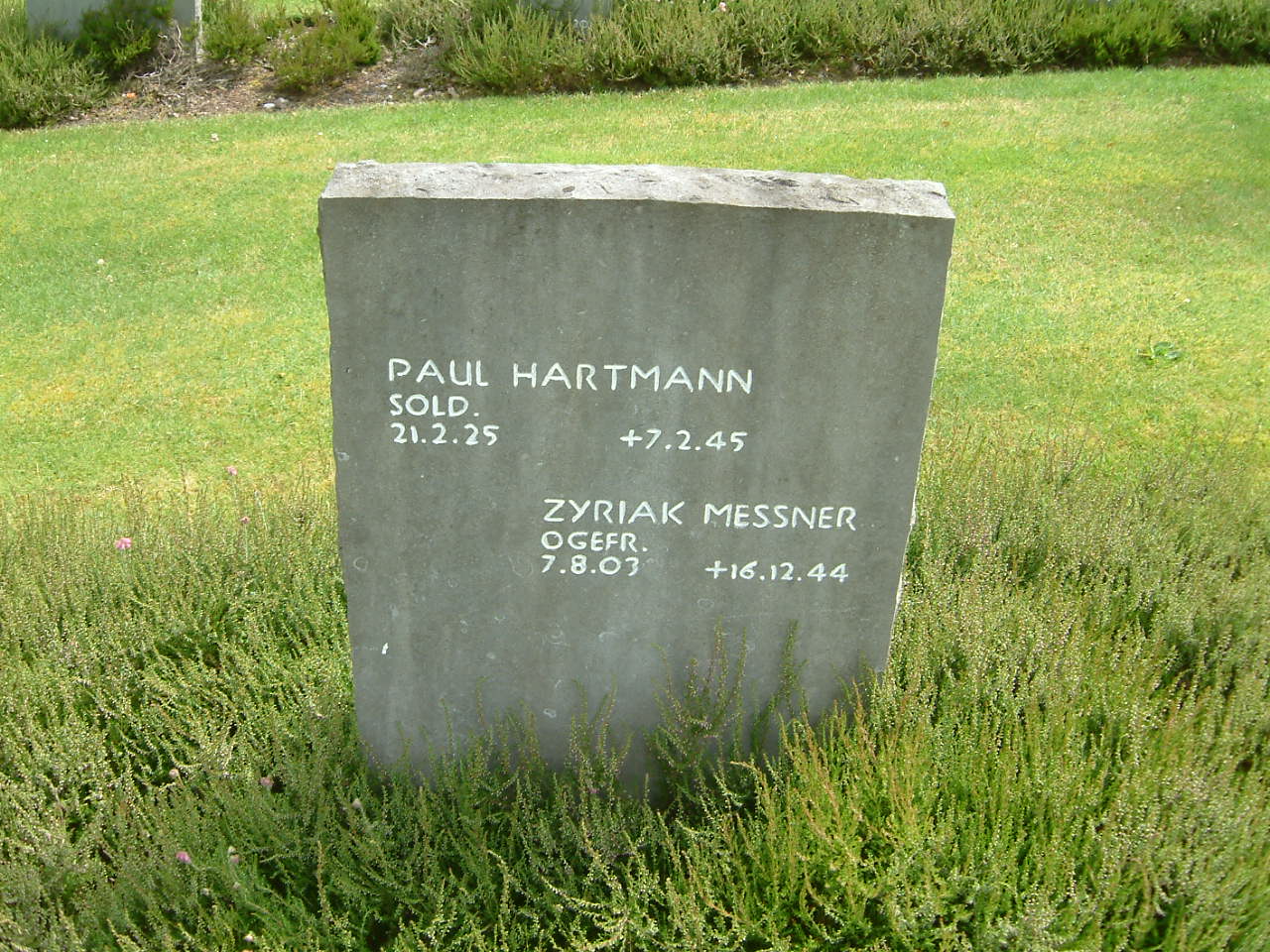
http://www.findagrave.com/index.html
That was fast! Ironically I once chanced upon the Cannock Chase cemetery by accident – i had not been aware of it until walking past from the Chase carpark.
It is certainly a more fitting resting place than Greenacres. I had never really thought about the POW camps in the UK before and so this week have read some fascinating stories about Oldham and Bridgend etc.
Thanks again Ian.
Glad to have helped with your interest in PoW camps Donald. Cannock cemetery is a lovely place, was built around the existing trees and the spot was chosen because it looks like some parts of Germany. Last time was up there my wife and niece were watching Paloma Faith at Cannock while I took the opportunity to visit the cemetery.
I am currently involved in a project with regard to one of the seven German prisoners who escaped from Glen Mill the day before Paul Hartmann was killed. It was at the roll call to discover who was missing and the unrest among the Germans at this roll call that resulted in Paul Hartmann’s death.
At the time of his funeral the Daily Herald front page gave a short report of his funeral together with a picture of his comrades saluting at his graveside. I have a copy of this but dont know how to post a picture on this site. The quality is not very good though. Oldham archives have two pictures of his funeral but I could not get copies from them because of copyright infringement.
Thank you David, you could email it to me, then I could upload it? Be interesting to add to the narrative.
That’s very interesting David.It will be good to see the photograph on the site.
I used to play in the Pill Boxes around the old mill and my Grandad used to tell me stories of a German POW from the mill who he became friends with after he returned from the war. It took along time to repatriate the prisoners back to Germany.
They kept in touch for a longtime but sadly lost contact when the Berlin wall was built. I wrote a little about the mill and the POW camp in a book ‘Oldham Discovery Walks’.
Look forward to seeing the picture.
Best regards,
Chris
Regarding Paul Hartmann who was shot at Glen Mill. I work as a gardener for a man who who was a junior in the labs at the hospital where Paul was taken. He said the German officers kicked up a stink about the sentry using a dum dum bullet or something due to the mess of the lads head. They were taken down to the hospital and shown the skull with the bullet still embedded in it. They were shown great respect as German officers not mere pows
Interesting anecdote Tim, thanks for adding that. Did the Germans leave satisfied that it wasn’t a dum-dum round? Or was it? Be surprised if it was.
He says yes they accepted it was just a 303 round when they were shown it. It just did a lot of damage when it hit the lad.
From the description it sounded a mess. Thanks again Tim.
Ian
Hello,
I have read the posts on your site with much interest as I live in houses just off Whellyhole street which are opposite the Glen Mill site. The house I live in is where the timber bungalows of the Arthurs Institution used to be. There are new houses currently under construction on the site of the Glen Mill. I have lived in this district all of my life and my mum has told me of German POW visiting her and my grandparents house on Huxley Street Clarksfield area whilst being held at Glen Mill. If you need any photos of the current location and development taking place now I would be happy to post them on this site.
For those with an interest, please see this page which has sketches made by a German PoW at Glen Mill. I added these some months ago and last month I was in contact with the artist’s son who sent me some more images including a PoW Index Card from Glen Mill. The additional images are at the top of the page.
https://aircrashsites.co.uk/britain-at-war/cover-2/
Page updated with a handwritten account by a woman remembering the friendship she and her husband forged with 2 German prisoners from Glen Mill. Please see EDIT SEPTEMBER 2016 directly above this comments section (there are about 130 comments so you will have to scroll up a fair bit).
In the late 50s my family moved to Greenacres from Westend Street. At the top of our street, Prince Edward avenue there was a rough track between the cemetery wall and rows of allotments. I remember noticing the German crosses on graves close to the Clarksfield road gate. We often played in the field at the end of a track leading to the Glen Mill.
The track led down past the bottom of the cemetery, towards Constantine street, to the bottom of Ramsden’s Field on the right and remains of the garrison on the left. There were a couple of huts, some foundations and a lot of weeds coming through old concrete and tarmac. There was a concrete ramp for vehicle maintenance that my father once used to underseal our car. There were the remains of a kind of railway signal box as if there had been a rail halt. At one point the Oldham corporation regenerated the garrison site as a rehabilitation unit for handicapped people. I recollect it being called the “Arthurs Centre”. The mill, or at least part of it, was in use for some of the time by Vitafoam, making foam matresses. Later the area around and behind the mill became overgrown and a great spot for ratting. The mill lodge down the street was fun for fishing as the water was always warm and the fish were huge (so it seemed at the time)
Many thanks for ading your vivid recollections of Glen Mill, Brian.
My grandfather was foreman gravedigger at Greenacres cemetery and the prisoners used to help there.Women used to leave cigarettes behind gravestones for them and my grandad pinched them.I went to Clarksfield school and just inside the entrance to the cemetery on Clarksfield road there was some German graves of prisoners that died at the Glen Mill.
Hi David,
Thank you for the information about the graves in the cemetery. I also used to go to Clarksfield School (in the 70’s and very early 80’s).
Whilst I’m sure my grandparents pointed the graves out to me, I don’t remember them. I will go and have a look at them sometime soon.
Best regards,
Chris
The graves in Greenacres cemetery are no longer there I think they were dug up and the bodies reinterred somewhere else .
The remains of the PoW’s were disinterred in the early 1960 and re-buried in the German War Cemetery, Cannock Chase, Staffordshire
I read the various stories with great interest. I was looking for mention of a German who was in Oldham around the time of the First World War. My Great Auntie Nellie used to speak of the most handsome German man she had ever seen. He used to play the piano, was tall and blonde. She used to swoon as she said his name. She died in 1980 and I remember his name had a rhythm as she spoke. I was trying to recall his name in the hope I would see something in print to remind me.
My great auntie knew of the stigma attached to going out with Germans and never did go out with her pianist whom she admired to the day she died.
Does anyone know of his name?
My Father was stationed at Glen Mill prisoner of war camp for his last posting of the war, he was a bugler who originated from Northhampton, He met his future wife, My Mother” at a local pub and spent the rest of his life in the Saddleworth area of Oldham.
Page updated with a copy of a newspaper showing a photo of PoWs giving Nazi salute at the funeral of PoW Paul Hartmann (referred to in the main text) who was shot and killed during a disturbance at the camp.
My father, he is still alive and 90 years old, was at that time at POW camp Glen Mill. He was part of this story with Paul Hartmann and told me the real story. He stood next to him and was sprinkled with blood from the hit of the bullet…
At that time the news told, that Paul Hartmann was a SS-man, but he wasn’t. He was a medic and last but not least a victim…
My father spend 4 years as PoW in England and came home in 1948. He kept his experiances in English camps and later on also outside in best memory. He still remember a lot of names of the English staff…
We are putting on a ‘War Memories’ event at Manchester Central Library on Saturday 4th November 2-5pm. Would you like to come?
With the endorsement of WarGen, Central Library and the Manchester Indie Film Makers Group (MIFMG), are presenting a single performance using film and written material from the published WarGen (veteran and civilian experiences during WW2) pages on the internet, with a bias towards the North West.
This performance is timed to be close to this year’s Armistice Day, just one week later, and will be in remembrance of all who lived and showed such bravery during the First and Second World Wars.
All are welcome, please let me know if you’d like to come: r.jacobson@manchester.gov.uk/ 01612341981
Ruth, I’m glad you found this group.
UPDATE
I have very kindly been sent some images and information about an inmate at Glen Mill, a Luftwaffe pilot called Feldwebel Vater who made some sketches of the mill and life in the camp.
The images are in the main narrative above under the heading UPDATE 25 NOVEMBER 2017
My father, whose name was Erich Breuss, was a prisoner in the Glen Mill camp, he escaped the day before the death of prisoner Hartmann, according to what I have been informed, my father was recaptured at the Castleton train station and returned to Glen Mill. Very good all the information of that time on this page. Thanks
Hi Federico, thank you very much for your comment. I have very recently acquired a lot more information about Glen Mill PoW camp including an account from someone there at the time referring to both the death of Paul Hartmann and at least one escape attempt. I hope to sort through and add this additional info to this page in the coming days or weeks. If there is anything relating to your dad’s escape attempt, I will send you an email advising.
Ian
Hi
Fascinating accounts of Glenn mill Oldham.
Let me add a little more.. Whilst serving in Rheindahlen Germany in the late 70’s and attending a dinner was asked by a German officer where I came from. Not thinking he would know of Shaw (small town next to Oldham) I said I was from Oldham near Manchester.
“Ahh” he replied “I was a prisoner of war in Oldham” then mentioned the Glenn Mill and how he was well treated and of the local people.
On leaving the Army I eventually returned to this area and met my wife. Living on Breeze hill road..Chatting one evening she mentioned her grandfather-Walter Burns-was a guard at Glenn mill in the early 40’s before being posted to Malta for the rest of the war. Her father, a small boy then, used to sneak into the camp and “borrowed” the issued army blankets so they could be made into clothing.
Later I was to use the site of the Glenn mill to park my training vehicles..
I seem to remember there was originally an arched railway bridge that spanned wellyhole st and this was the camp gates..The guards etc where billeted in the old wooden spider huts opposite to the mill. Concrete air raid shelters on the small hill opposite the mill are still there overgrown now.
Great article…Memories…
Hi Ian, thank you for sharing your memories, very interesting to read.
My Father and his twin brother Frank and John Cresswell were both guards at Glenn Mill. They were born in Herefordshire.
My fathr Frank met and married my Mother Bertha Flynne and after the war ended he stayed andin Oldham and lived in the Salem area of Lees, this is where we were born.
He told us that prisoners would be escorted on arrival from Mumps railway station and marched to the camp.
Sadly my Mother died in 1961, my father in 1969 and we lost touch with my uncle. I would be very interested if anyonee knew of the ‘Twin’ guards.
Sunday 22 September 1940
4(F)/121
Junkers Ju 88A-1 WN.0352.Failed to return from weather reconnaissance
sortie over the Channel and shot down by fighters into the sea.
Lt.Boettchr,Fw.Vater,Uffz.Mueller and Uffz.Rabe all took to dinghy and captured. Aircraft 7A+AM lost.
Source .Battle of Britain Now and Then .Vol 5. page655
My dad was a guard at Glen mill, he is now 93.
My father was a German prisoner of war at Glen Mill camp and at Mortimer camp from 1943 to 1945′ Walter Siegfried Gabler. I have photos and a book by Miriam Kochan called “Prisoners of England”. He remembered the shooting of Paul Hartmann. How do I find records of my dad? He married my English mum and they ran off together behind the iron curtain with me in 1951. I have newspaper reports in English and German, a big scandal at the time.
As a child we lived in Oldham. On Christmas day we welcomed 2 prisonets of warfrom Glen Mill into our home for the day. One of them was called Waltar. I cannot recall his second name. I wonder it by some small chance he could have been Annmarie’s dad.
It would be a small world! Dad never spoke much, but I do have photographs. He loved football, gardening and small birds. He was 18 when captured in France. I am glad he was out of the war. He came from Dresden. I wish you all the best . Annemarie
I would like to see the photos of your dad. Is it possible to email one or two. Thank you. Frances Bradburn
Does anyone have any idea how Constantine st got its nickname the ‘Bunk’ ?
That’s the street on which the Glen mIll POW camp stood?
Alan Muldowney
Hello – excellent site, so many interesting details!
Does you know about the numbering for this camp? I am trying to piece together dates for various camps. I know it was Camp 2 – but then a camp list from 1947 lists it as 168, and the English Heritage report lists it as Camp 176.
As the camp was emptied in 1942 and the pows sent to Canada, I was wondering if, when it was ‘re-filled’ that was one of the times the numbers changed? Thank you.
My Mum worked at the Sebastian Ziani de Ferranti works in Oldham towards the end of the war they asked would anyone take a German Prisoner home for the weekend you would get extra rations Mum said fine, on the bus home they got funny looks. He carved in wood 6 napkin holders sad to say lost, he did send letter after the war said he missed the British breakfast.Dad was in the Oldham Fire Brigade Dad got find 2 pounds for shinning his torch helping a lady from a house on fire Mum never for gave the Oldham Police for that fine
lived around welly hole st around 1973 was 8 at the time remember the air raid shelter on welly hole st. My mates mum and dad managed nuffield hostel on welly hole st for the disabled think his dad was called ken Thompson. they had an air raid shelter on there grounds was a long tunnel underground but was all blocked off. Live in lees now find this really fascinating stuff
Hiya Howard, thank you for your visit and for your memories. Hope you and your family and friends are safe and well!
Ian
Hi Howard,I too lived on Wellyhole st from 1958 till 1970 when we moved to Greenacres because of the area being demolished.Used to spend a lot of time at the Nuffield centre with the Thomsons daughter Linda l think she was called.Remember the air raid shelters very well except for the one you speak of,never knew that existed.As kids we never knew their significance or importance,neither of us seem to have moved very far away.
In the 1950’s and 60’s I lived on Eric Street, Clarksfield. My friends and I played rugby in Greenacres Cemetery on the slope below where the graves of the POW’s were.
Vitafoam had the Glen Mill then and there were still pill-boxes on Wellyhole Street and bits of the fence.
My mother used to talk about the prisoners marching around the district and that some, the better behaved ones I suppose, visited local homes to share Christmas meals.
There was an electrician’s shop on Lees Road facing the Red Hall Street junction, I believe the owner was a German POW who stayed.
When I started work I dealt with a lady from Derker called Mabel Blagborough. A colleague told me that during the war Mabel would go into the cemetery to a spot above the road and throw sweets over the fence. he said the prisoners called her ‘The Lady on the Hill.’
The late Ray Gosling did a piece for Granada Reports about the Glen Mill camp in the 1970’s.
Hi,Mabel Blagborough was known as the Angel of Glen Mill.There are articles about her at the Local interest centre on Union st.She did indeed live on Thackary rd Derker and died on Rose Hill Court,Waterhead in 1986.She fought hard for better conditions for the POWS at Glen Mill and because of her persistence was allowed in to see what conditions they were living in.
Fantastic site! I was spending an idle hour during lock down. I can across the site by accident. I remember the Glen Mill well, as a child my uncle Clifford Brook was a manger at Vitafoam who started off at the Glenn, I remember playing on piles of old tyres outside the mill.
My family who lived in Oldham mentioned the Mill when I was a child. My dad told me of the POW’s who where held there. One of them visit my uncle Bob and Aunt Eva (Stafford) at weekend. They lived on Spring Street. He wrote to them after the war. My Uncle Bob worked in Greenacres Cemetery as head grave digger for a number of years.
As as young child I played with a lad called Karl Heckkermann, the family lived near what was known as the “Mill Bottom” near the Cairo Mill. I remember his dad was German and I think he had been a POW at Glenn Mill.
Fantastic site, really enjoyed reading the stories on here.
Pete
Thanks Peter, glad you like these pages!
Ian
Hi Peter,l too played on the tyres at Glen Mill as a child.I was brought up on Egyptian st,the other side of Wellyhole st,from the age of 7/8 but both set of Grandparents lived there from the early 1900s and l spent a lot of time with them from a young age.They used to tell me of the POWS and the insults they got from some people as they passed by.l knew Len Shaw and his family who was also a boss at Glen Mill and Vitafoam.What l would like to ask you is/was Karl’s father called Otto by any chance?l believe Otto was highly thought of locally and did peoples gardens and other odd jobs and was invited in for Sunday lunch.I have a lady who lives across from me and as a child used to take him lunch when doing jobs for her family and near by.I believe he married a local lass and lived in Lees?for a time before going back to Germany.They stayed friends for many years,writing and visiting each other regularly,and he always spoke fondly of the local people and how kind they were to him.When we are able l will try to have a chat with her and get some more of her memories.
Hi Kurt,
I was spending a lazy afternoon during lock down looking at bits of my childhood history. Long story short, I remember the Glen Mill very well.
I went to school with or certainly played with a Karl Heckermann, the family lived in Waterhead near the Cairo Mill, know as the “Mill Bottom”.
If it is your family I did meet your Mum and Dad on at least one occasion.
To be honest it was a very long time ago, probably back in the early 60’s
Kind regards
Pete
Hi everyone, I am Jonathan a 39 year old man who actually lives in lees and now directly were Glen Mill POW originally stood, now there are houses built and I’m living in one.
I used to go to St Edwards School as a child and remember walking past this site daily but never knew anything about its history. Now reading all these stories and the history behind it has actually shocked me.
I am now intrigued to know so much more and can not believe that this was a POW camp that my house is now built on. I’m thinking of all the poor people who would have had so many difficult days and nights here and my heart goes out to them all.
Hi Jonathan, thanks for your visit and comment. I am pleased you find this story to be of interest. I love finding out local history and posting it on here for people to find.
Ian
This sight was linked to a photo of the Glen Mill on the Oldham Then And Now Facebook Group.
A few years ago I was told that my Grandparents hosted a couple of POW’s for Christmas lunch. I have no idea what year and assume that it would have been towards the end of the war. Maybe 1944. One of them could speak English and the other couldn’t. One of my Mother’s memories of the day was being taught to sketch by the one who couldn’t speak English.
It wasn’t a popular thing to have done and some of the neighbours didn’t talk to them for some time. What they wouldn’t have known was that my Grandfather had been a POW in Germany during the 1st WW. I assume that as a 17 year old they had treated him well and he reciprocated.
I can’t verify this but I vaguely remember being told that at busy times he had a couple of POW’s working in his bakery and that eventually they arrived without an escort.
Hi,I was born on Ceylon St at Breezehill, Oldham in 1949 and have always been fascinated by the story of a German HE bomb exploding nearby in
Oct 1941.
When we were little our back bedroom window had a pane of distorted replacement war glass, dating from the blast, which was impossible to see through no matter how often it was cleaned.
Many windows in tbe area had been reputedly blown in by the shock wave that night including the stained glass windows of Salem Moravian old church at the top of Salem Brow.
There doesnt seem to be any photographs of the damage done at Breezehill or a list of the injured and homeless.
Thankfjlly according to official records no fatalities were sustained there.
Over the years bits of information have come my way regarding the bomb, including the fact that the first two houses on Breezehill Road, after the corner junction with Vigo St, were badly damaged and had to be demolished soon after.
(A pair of semi detatched new houses replaced them in the early 60s.)
What has never been made clear however, is where exactly the bomb landed,
as in all the years of “playing out” as children in the 1950s & early 60s we could find no evidence of any crater.
We do know that most of the rubble from the demolished houses was dumped in the nearby Medlock Valley.
Whilst recently browsing your excellent site and reading all the illuminating comments about the POW camp at The Glen Mill on nearby Wellyhole / Constantine Street, going back to 2007.
I came across an entry for that year conected to a bomb falling near the Glen Mill at Breezehill.
The writer Doug Charnly said his father had lived at Breeze hill when the crater was clearly visible 100ft above the banking and he himself remembered seeing it as a boy.
I was wondering if Doug ever expanded on this comment and also wether anyone else has any photographs or information on this forgotten even.
One further comment from me regarding the draining of the Glen Mill lodge.
When it was drained before demolition the muddy residue contained hundreds of rusting tins of fruit and condensed milk. This appears to confirm that local people had felt sorry for the German pows and had thrown the tins over the camp fence
undercover of darkness in an effort to give them a treat.
Hi Neil,have you joined the local group,Oldham Past And Present? I’m sure it was this group that not so long ago there was a post on the bombings in the area,including Abbeyhills rd.I am sure you will find someone there who may have or know of the information you are looking for.You could also check out the Local Interest Centre at the old library who recently did a display of the Glen Mill prisoners and related articles in the market hall.You can get all kinds of local information there.
Thanks Patricia I will give that a try. Most of the other bomb sites from the 12/13th Oct 1941 raid seem to have been well documented but Breezehill is the odd one out.
Me and my family moved on to Walter Mills Way in 2016 and knew of the history of Glen Mill.
I have always checked this site for information but was unable to pin point exactly where it was located.
That was until this week when a production team from Channel 4’s Digging For Britain knocked on the door! They have the layout and coordinates of where the Mill stood and are looking to dig in ours and our surrounding neighbours gardens to unearth some of the Mills history for the show. They are looking to do this in mid-June and I’m sure they will be looking at this site and reading these stories with great interest!
It will be great to see what they find!
Looking forward to what they find out . My dad was a guard there after he was wounded in Italy.
His name was Fred Rowley he had a sister Harriet who married a Sam Boardman?? . Regards Loraine
Hi Lorraine, my wife and her family are all Oldham born and bred but I only moved over here in 2009 so it’s unlikely that Sam is a relative but you never know!
I’ll post any updates I get regarding the dig. They generally have a tent set up nearby the locations where they dig where people can go and inspect their finds. Fingers crossed that’s what they do here.
I am part of the channel 4 production team for ‘The Great British Dig’ that Ben Boardman has said above (thanks for the mention). We can’t wait to get excavating in that area and see what we find of the mill and its use as a prisoner of war camp.
As part of that I have been looking through all these comments on this page and there are some truly incredible stories of people that remember the camp itself or have stories from relatives that interacted with the camp.
We would love to hear from anyone that is still local to the area and was around when the mill was being used as a PoW camp or could give us an insight from stories they were told by relatives. If you believe you could help us, please get in touch on my email: ben@strawberryblond.co.uk
I can’t wait Ben! We are all really excited to find out more about what’s underneath our feet!
Hopefully see you soon!
Hi Ben
I was so interested to hear about the Great British Dig programme you produce. When is there an airing of the Oldham site ref Glen Mill ? How could I watch it?
I have learned about this POW camp whilst trying to find the identity of a young German POW from WW2 who worked on my Grandparents farm nearby to the camp. My auntie who is still alive remembers him but we don’t have a name or DOB so have so far not had much luck. We just wanted to thank his family for his work and find out what happened to him after the war. It is such interesting history.
May 2021 Channel 4 production team for The Great British Dig are starting a project on Glen Mill when it was a POW camp.They are looking for anyone who was around at the time or who have stories from family/friends to contact them via email to- ben@strawberryblond.co.uk.Thanks.
My stepdad’s father was J A Jaffray
I was born alongside Glen mill in the forties and we used to play with the prisoners of war on the croft at the top of our street Roman Street which can just be seen in one of these sketches . The sketch that shows the Glem Mill with the Atens Mill in the bockground. There is also another mill that should be shown in the scene but is hidden behind the Glen mill that is the Owl Mill. The Alottment in the foreground is my grandfatrhers ‘pen ‘ or allotrment and the mill behiond the rows of houses is thge Windsor . Tghe streets are the Egyption street and the back of Roman street just visible
The scene called Cotton Mills in Oldham are of the Owl Mill, Athens Mill and windsor Mill.
The allotment in the foreground belonged to the residents of the streets just visible to the right of the picture .The streets are Egyption St and Roman St were i was born. My grandfather kept a ‘pen’ in the allotment.
Ian, what a great read cheers mate. My Dad was captured at st lo and brought to Oldham he was stood a few feet from his friend Harttman when the guard shot him. He never told me much about that period, only that he went to Oldham them camp 88 Mortimer near Reading, so it must have been Glen mill i remember he did say about the shooting incident, he was a tool maker from Dresden, we ended up in Swindon,where i was born and he stayed as a toolmaker for British Leyland, strangely enough i became a firefighter and ended up serving for Royal berks Reading and Mortimer lol. My son has now completed 8 years in the RAF my old man would be so proud. Cheers Ian regards Dee. (Dietmar Gabler)
Hi Dee, great to hear from you and read something of your dad’s history. I really appreciate it when people find this page and leave a comment about their relatives.
Best wishes to you and your family,
Ian
Hi, I love anything to do with Oldham history and have just been to my nan and grandads, my grandad in particular is a wealth of knowledge and has quite an interesting family history himself. His dad was German and one of the managers at Oldham Elastics. They had a large house on the corner of Spring street and ?Redgrave Street, 2 houses together but they owned both (I think it may have been a half way house in the 90s and now demolished). Apparently my great grandma, after seeing pow behind the barbed wire wall at Glen Mill, wanted to help and ended up housing 10 girls from there, all in their teens, in the attached house which had 14 bedrooms. Apparently she didn’t want boys, thought they’d be too problematic but did end up taking 3 lads. My grandad said she had a seat made to sit in the hallway to oversee there was no funny business going on! My grandad said she was like a mum to them and began to tell me tales of the people who lived in the adjoining house and settled down to live in Oldham. He said he was younger than they were and he was born in 1936 so would’ve thought this was in the late 40s early 50s.
After my visit I googled Glen Mill and came across this site.
I can’t recall ever hearing about females being kept as POW at Glen Mill.?There were however females living in accommodation across the road who were of different nationalities.They came over to England late 40s early 50s at the request from our government l believe to work the mills,machinists etc.I have a neighbour who is from Austria and came over on said scheme at the age of 19 with friends from the same village.She didn’t stay at the accommodation across from the Glen but knew women who did.Some were Italian and l think she said Polish,some of whom she worked with.There were strict rules and regulations about how they had to behave and if they broke any of these rules they would be sent back home.She and some of her friends married and made a life here and she has been here for over 70 years.
Hi Patricia, after the Glen Mill ceased to be a P.O.W. Camp it became a short term place of residence for EVW’s, European Voluntary Workers and people from all over Europe who were known as “displaced persons” due to bring taken from their home towns and transported to places to work for the Germans as slave labourers. Many of these people were unable to return home or didn’t wish to return home if their county was now under the thumb of the Soviet Union. After the war the government said Britain needed extra workers to help rebuild our industries e.g. women to work in the cotton mills in Oldham and surrounding towns. Many of these were women from Poland, Ukraine, Austria etc. As far as I know no female prisoners of war were held at the Glen Mill. Other E.V.W.’s lodged with families or found places that had been turned into flats to house them. One such place was a doctor’s house and surgery on the corner of London Rd and Derker Street, Oldham, known as Pitt Bank House.
I had no idea about this Sue, thank you so much for adding this vital information about the history of Glen Mill.
Hi Sue,Thank you for that,it confirms what l had been told.Trudy and l were only speaking of it yesterday when talking of trying to be organised.She told me she had to be when she lived in lodgings when she came to Oldham as there was very little room for anything and a lot of things had to be shared.If my memory serves me correctly,are you the Sue from our local interest center?You may remember Trudy/Gertrude when she came in to see you a few years ago and you asked her to translate some letters you had obtained from once POWS from the Glen Mill.I will tell her of your contribution on here and ask her where it was she was in lodgings.
Hi Patricia, yes I am Sue from the Local Studies and Archives and yes I remember Gertrude coming in to see us. Please give her my regards.
Hi Sue.I mentioned you to Trudy today.She said she enjoyed doing the translations with you and intended coming back to see you,but with the last 2 years with the covid she has rarely been out of the house.She did tell me that she stayed in lodgings on Acre Lane on Derker when she came to Oldham that was owned by a Polish family. I will pass on your regards.
It must have been accommodation across the road then mustn’t it? Interesting to know. Thank you
Many of the women were EVW’, European Voluntary Workers, many of whom had been displaced from their home countries due to the war, this can be seen in recent events in Ukraine and in other places in the Middle East and Africa. Very sad.
Hi Sue.Did you take a copy of the work Ian did on Gertrude Costello? You mentioned at the time you would like it to be saved in your archives for posterity.Well l was speaking to Trudy about it today after her daughter in law brought her a folder with her history that Ian had done all safely put together. She has no problem Ian’s work on her being kept by you if Ian is ok with it.
Hi Ian, l will be in touch shortly,keep meaning to msg you and Trudy reminded me today to have a catch up.
Hi Pat, often wonder how you both are doing? Please say Hi from me. Ian
Hi Patricia, thank you for your message regarding Trudy Costello. I have now retired from the Oldham Local Studies and Archives, but I am certain that the archives would be very pleased to have a copy of Trust’s memoirs. The phone number is 01617704655 or 01617704654, please ring after 10 a.m. The archives manager is Roger Ovens and the archivist is Caroline Knight. I hope Ian won’t mind, but ask him first. Many thanks once again Sue Smith.
Fine with me!
Ian
Seeking information on a German POW, Walter Reeh, who may have been held at the Oldham, Lancashire, camp. A photo of a group of 13 prisoners, including Walter, taken 5 May 1946, includes a placard at their feet that includes the date, a large number “2” and the initials “OL” which leads me to believe they stand for Oldham, Lancashire. The photo postcard was sent to Walter’s brother, Reverend A.E. Reeh, First Baptist Church, LaSalle, Colorado, via Prisoner of War Post, or Kriegsgefangenen Post. A stamp on the back of the postcard reads: “German P.O.W. (W) Camp 235 Gt. Britain.” I would be happy to post the photo to this site, if I am allowed to do so.
Hi John, my email address is on the contact page
Please email images of both sides of the postcard and I will add them here.
Ian
Hi John, my family lived on farms near Hyde not far from Glen Mill and did have a German POW that worked for them but we do not recall his name and have made attempts to find out more about him but to no avail currently. However my cousin still lives in the area still and talks about a German solider called Walter that lived in that area which he knew. I believe Walter was in a tank which was active in Russia. I will try and find out more for you about this Walter in case there is a connection.
Page updated with photos and request for information. Please see the main narrative above, under today’s date.
Ein tolle Seite ,die vielen Berichte tun mir weh.Es ist schön das sich viele Menschen an
diese Zeit im Glen Mill Pow Camp errinnern.
Hi Fritz, happy new year! Great to hear from you. I hope you and your family are in good health.
Hallo Fritz, guten Rutsch ins neue Jahr! Toll von dir zu hören. Ich hoffe, es geht Ihnen und Ihrer Familie gut.
Ian
Vielen Dank für die Neujahreswünsche !
Wir wünschen Ihnen und Ihrer Familie ebenfalls alles Gute für 2022.
Bleiben sie gesund !
Fam. Fritz Frauböse
Hello. I recently found a recording of an interview with my grandfather who was a German POW who settled in england. I have transferred the recording from VHS to digital format. It was a Granada TV production about German POWs who settled and married English women as my Grandfather did. In the interview he said he was sent to Oldham and was worried about hardcore Nazis who were threatened reprisals for any German who cooperated with the British. He was offered the chance of working on farms and took up the offer and came to Cumbria where he stayed. I would like to know where he was captured and where he fought and wondered if there was any clues in the prisoner records, if there is such a thing. Is there a record of the prisoners who were kept at Glen Mill and where would I find them.
Any suggestions would be greatly appreciated
Thanks
Jonathan Schug
Hi,
It looks like the Great British Dig episode about Glen Mill will be broadcast on Monday 18 April 2022 at 9pm on More4.
Ian
I kept looking out for it. They filmed some of the programme at the Oldham Local Studies and Archives using the original plans of the mill and some of my display boards, but not sure what will be used. I met the whole team, but it was filmed during the covid closure, but interesting seeing the way the filming was done. Very hot lights!
Hi Sue, good to hear from you.
I was with the production team one afternoon last summer at their base on Constantine St. They filmed the stuff with the water colours by PoW Friedrich Frauböse.
The crew were lovely. I chatted briefly with Hugh Dennis, then a few weeks later was at the cinema watching the Bond movie ‘No Time To Die’ and saw him in it. I think he was the second or third person to get shot, which really was no time to die.
Ian
Hi Ian, I have your details regarding your website when the production company first contacted Oldham Local Studies and they said they’d already been in touch with you, which was great. I don’t know how much of the filming they did in Local Studies will be in the programme, but I was their contact and produced the archives for them to look at. I’ll have to record the programme as I will be away but looking forward to seeing it. Take care, Sue
Is there a date for it to be televised now?
The season restarts today. According to a couple of sources online, the episode about Glen Mill is Monday 18 April at 9pm on More4.
Sorry, you were asking Sue, not me!
Ian
Thats ok Ian either of you would do, I just didn’t want to miss it.While we are chatting l have a photo on my phone of an ex POW that my neighbour had but dont know how to download to your site,can you help?
Yes please email me Patricia and I will add it to the main narrative above along with any other details you can provide.
My address is Iandb@gmx.com
Ian
Hi Ia have you tried Facebook. There are many Groups on Oldham at least one or two looking for old friends or relatives The children on the photographs would be in their 70s + now but msy have relatives in Oldham whi remember then . Worth a try. Good Luck Olwyn White xx
Thanks Olwyn,
Ian
Page updated with photo and story about former PoW Otto Adler courtesy of Patricia Clarke. See the end of the main narrative under heading UPDATE APRIL 2022
Update – a page added with an interview with Trudy Costello and some photos. Trudy was a mill worker in Oldham in the 1950s, she worked at Glen Mill for Vitafoam. Born in Graz, Austria in 1932, she travelled to Oldham after the war. In 1938, as a young girl, she met Hitler when he visited Austria after the Anschluss. These are some of her memories.
Gertude Costello née Kogelnik
Page updated with a record of a German PoW’s journey from capture to repatriation via (briefly) Glen Mill camp. Please see bottom of the main text above.
Ian
Hello, I am just in the process of buying a house on what was the site of Glen Mill, being something of a history buff one of the reasons for my buying the house is the history of the POW camp.
I have an idea of creating a feature wall with the history of the POW camp and would like to use some of the images on this site as part of that project. So I can share the history with my Grandson as he gets older.
I feel it is important to keep telling these stories so the history is not forgotten.
If anyone has the original source images, it would be helpful if I could get copies especially the hand drawn cartoons.
Hi Justin,
I have emailed you.
Ian